HIDDEN FOR 50 YEARS by its owners, the surviving 1968 Bullitt Mustang #559 revealed to public!
The secret I kept for 28 years can finally be told!
By Brad Bowling
On Jan. 11, 2018, after a lifetime of waiting, I saw the surviving Bullitt Mustang during a top-secret trip arranged by Ford Motor Co. and owner Sean Kiernan. Now, the rest of the public can see it, as well! (For more photos of my first visit with #559, see the gallery toward the bottom of this page.) Property Brad Bowling
JAN. 10, 2020 NOTE: Yes, I will update this page with results of 559’s sale in Kissimmee, Florida, as soon as I have time. Check back soon!
JAN. 14, 2018 -- Shocking everyone in the collector car universe, today Ford Motor Co. publicly unveiled the 1968 Mustang Steve McQueen drove in the movie Bullitt alongside the company's 2019 Bullitt Mustang special edition. The event was part of a press conference Ford held at 4:30 p.m. in advance of the North American International Auto Show at the Cobo Center in Detroit.
One of two cars used in filming, this one—known as "#559" from the final digits of its vehicle identification number—survived the famous chase scene intact because it was the close-up, or "hero," car most often seen with McQueen at the wheel. For more than 50 years, #559 was hidden from public view by a succession of three owners.
Perhaps the biggest surprise to the assembled automotive media members was the car's condition. After five decades in seclusion, the Mustang is in remarkably good shape. The body has scratches and dents, along with some surface rust. The driver-side rear quarter panel has a minor amount of rust-through and an obvious body repair. The American Racing wheel spokes have a patina of rust. The 390ci, S-code V-8 engine was recently rebuilt by its owner. In short, it looks like the kind of barn find that any car collector would be thrilled to stumble across.
Because of my extensive history with this car and its three owners, I have been aware of the impending reveal for the past several months, and I was asked to participate in a documentary being filmed about #559. Ford invited me to attend a top-secret advance viewing of the car deep in the bowels of its Detroit Product Development Center (PDC), which took place Jan. 11. The PDC is where engineers and stylists brainstorm special products such as the latest generation Ford GT and the new 50th Anniversary Bullitt Mustang. It was also my first chance to meet #559's owner in person, after working with his family on this story and maintaining their privacy since 1989.
Before I get ahead of myself with this timeline, let's start at the beginning. Here now is the full, uncensored story of the 28 years this writer has spent investigating and chronicling the history of #559.
I am providing the following anchor links to help readers navigate this 8,000-word document.
JUST WHAT THE HECK IS A BULLITT MUSTANG, ANYWAY?!
Gifted with hindsight, it’s difficult to consider thinking of the surviving Bullitt Mustang simply as transportation, but that’s exactly how it was treated by its three owners for many years.
Steve McQueen was the King of Cool.
Steve McQueen was a hot property in Hollywood in 1968. He had just completed The Thomas Crown Affair with Faye Dunaway, and he was enjoying the kind of creative leverage every actor works for. Because he wanted more control over the production of his movies, he signed a six-picture contract between his Solar Productions and Warner Bros. The first (and ultimately only) product of that collaboration was Bullitt, based on the novel Mute Witness by Robert L. Pike. Originally optioned by television producer Phil D’Antoni as a “facing retirement” cop role for Spencer Tracy in New York City, McQueen’s interest in the project brought about major changes in the script--including the addition of an intense chase scene. English director Peter Yates, a former club racer who once served as Stirling Moss’ race team manager, was hired to helm the movie.
As with most successes, the Bullitt chase scene had many fathers. McQueen, Yates, and the two men credited with writing the screenplay – Alan Trustman and Harry Kleiner – have each made claims in interviews that the idea was theirs. Regardless of heritage, it is a tribute to McQueen’s persuasiveness and credibility that the city of San Francisco agreed to the mayhem he proposed for its streets. (Picture the meeting in which negotiations took place: “Okay, Mr. McQueen, you’d like to race two cars through our city at 100 miles an hour; could we interest you in burning down some of our buildings?”)
To get McQueen to sign on for the movie, Warner Bros. assumed a tremendous financial risk by giving in to several of the star’s demands. McQueen wanted every shot to have the grit and texture of the real 1960s San Francisco scene, which meant that easy shooting in a studio backlot was forbidden. Realism was enhanced by the use of a new Arriflex camera, a lightweight wonder that gave director of photography William Fraker tremendous mobility and flexibility.
Action was captured on celluloid from a Corvette-based chase vehicle known as the “Bullittmobile.”
Whether or not McQueen specifically requested his character drive a Mustang is unclear. An ongoing product placement arrangement between Ford Motor Co. and Warner is most likely the reason for the choice. Two Highland Green fastbacks sporting GT packages, 390/4V motors and sequential vehicle identification numbers were shipped to the studio. The cars wore VINs 8R02S125558 and 8R02S125559. Likewise, two new Dodge Chargers were purchased, reportedly with 440ci V-8 engines, for the bad guys to drive. Hollywood car builder and racer Max Balchowsky modified all four cars with extra welding, bracing, suspension, and engine work to handle the heavy abuse. The Mustangs’ shock towers were stiffened, and Balchowsky installed heavy-duty front springs, thicker anti-roll bars, and Koni shocks. A power increase came from milled heads and ignition and carb upgrades. Several pieces were removed from the Mustangs, including the driving lights, running pony grille emblems, Mustang lettering, and even the GT badges. Stock wheels were pulled in favor of sportier custom rims from American Racing.
The fastback assigned to jump duty, #558, also received a rollbar-mounted camera so that thrill-seeking moviegoers could get a taste of what it was like to fly through the air above San Francisco’s hilly pavement. Not only did #558 get trashed performing the jump scenes, but it was also the car responsible for the fiery destruction of the Charger at the end of the chase. Special towing equipment was mounted to the passenger side of the Mustang, and two dummies were placed in the Charger so that, through clever editing, it would look like the Mustang ran the Charger off the road into the gas station where it blew up.
Carey Loftin was the movie’s stunt coordinator, with Bill Hickman acting and driving the Charger. Bud Ekins, a motorcycle buddy of McQueen who had doubled for him in The Great Escape, was hired to drive the Mustang during the dangerous downhill sections.
Because #558 was so damaged by the time shooting ended, people behind the movie reported in interviews that it was sent to a junkyard and assumed crushed.* Bullitt #559 was repaired and sold privately.
* The rusted shell of #558 was discovered in a desert junkyard in 2017. For latest updates on #558, google "lost Bullitt Mustang Mexico."
HOW I CAME INTO THIS STORY
As a boy growing up in northeast Mississippi, I would stay up late on Friday nights to watch all 90 minutes of The Tonight Show. Back then, Johnny Carson signed off at midnight, at which point our NBC affiliate in Tupelo (WTVA) would run a half-hour or so of free programming before playing the national anthem and going dark. Sometimes it was a repeat of an NBC show from earlier in the week; sometimes it was public service announcements about tornado safety mixed in with promotional films for current movies.
Early one Saturday morning in October 1968—right around the time I turned five years old on Oct. 10—I watched a 10-minute-long film called Bullitt: Steve McQueen's Commitment to Reality. At that age, I didn't understand the realistic dialogue or care about extensive use of location shooting. All I knew was that a green car, looking like nothing I had ever seen in my small, rural town, had become the most exciting thing in my world. If I knew nothing else about myself at that age, I suddenly knew that I loved cars and that I could not imagine a future that did not revolve around them. The green car sounded like thunder, was blazing fast, and could leap through the air like a lion after its prey. The handsome man behind the wheel showed me that my world had strong, courageous people who would not give up their fight against crime and evil.
When I was in college in the 1980s, studying to be an automotive writer, I read a couple of articles about the two Bullitt Mustangs that indicated each had disappeared, probably to junkyards. (Those articles appeared in the December 1985 issue of Mustang Monthly and the March 1987 issue of Muscle Car Review. Each was written by Susan C. Encinas, with "I Was There" sidebars by Anthony Bologna.) I didn't want to believe that the most amazing car from my childhood—the iconic green beast that had made me passionate about something other than cartoons and hamburgers—was forever gone. I just knew that such an amazing machine had to still be with us, through sheer awesomeness, just like how Stephen King's Christine couldn't be killed.
After college, I spent 1988 as editor of Mustang Times magazine and most of 1989 in California as public relations coordinator for Saleen Autosport before landing a position as associate editor of Mustang Illustrated magazine in Anaheim. It was a bimonthly magazine I had been reading since relocating to California, and I was looking forward to doing some good work. I even told a few of my Mustang friends that this job would give me an opportunity to investigate the unknown history of the Bullitt cars.
"How neat would it be," I asked them, "if I found one or both of the Mustangs from the movie?"
NOTICE/DISCLAIMER: This article from the December 1989 issue of Mustang Illustrated is NOT anything I wrote about Bullitt #559. It is full of errors and misinformation, but it WAS instrumental in locating the actual car! Had I begun working for the magazine a month earlier, this mess would never have seen print, and I might never have found the surviving car. The universe has a really wicked sense of humor.
My happiness with the new job and dream of having my name attached to a piece of film history crashed into a brick wall almost immediately. During my first week at the job, the printer delivered the December 1989 issue, which had been written, edited, and laid out weeks before I had any connection to the magazine. In it was a two-page story with a headline that read: Found! Steve McQueen's Bullitt Mustang. For an instant, I was excited and amazed that the Holy Grail of Mustangs had been located. How had my coworker managed such brilliant reporting? In the next instant, I was sad that I would not be the writer bringing it out to the public.
Then... my eyes focused on the photo of the green 1967 fastback that accompanied the article! Anyone who had ever read a Mustang magazine or book knew that the two movie cars were 1968 models. At that point, I was devastated to see that the publication I had just joined had given itself a huge black eye that I could have prevented, if only I had been on staff a few weeks earlier. (I'm including that article here only because it is responsible for my next 28 years of writing about Bullitt Mustangs.)
Here is the first article I wrote about the Bullitt Mustang after interviewing Bob Kiernan in 1989.
The flood of letters and phone calls that followed made me both depressed and even more determined to right this wrong and learn the fates of the movie Mustangs. Approximately 10 days after the issue hit newsstands, when I was answering a dozen or so calls per day from readers complaining about the article, I got the shock of my life--a caller who had something new to tell me.
After some polite salutations, the man on the other end of the phone line calmly said, "I know that's not the real Bullitt Mustang, because I own the surviving Bullitt Mustang."
I am quite sure my eyes jumped out of my head and steam pumped out of my ears like a Looney Toons cartoon character, but I did my best to keep my voice composed.
"Really?" I asked. "That's great. I would love to see it sometime."
Here is a small sample of the complaint letters!
"Oh, I'm not calling to get it in the magazine," the voice replied. "I don't show it or really talk about it much. I just wanted you to know that it is out here."
Using my best hostage-situation-negotiator voice, I dragged out the conversation. Anything to keep him on the line.
"Oh, how long have you had it?" I asked, wondering if tracing calls was really a thing.
He told me, "I got it around 1972 or '74. It's been stored in my father's garage since 1980 or so. I haven't driven it since then, but it's in good shape."
This envelope contained what would become the first pages of my Bullitt Mustang document collection. Property Brad Bowling
The man on the other end of the phone, Bob Kiernan, agreed to let me write an article about his car, and he would provide me with a few pieces of documentation he possessed. The only stipulation was that I could not reveal his name or the location of the vehicle. I put together a new Bullitt article for the April 1990 issue of Mustang Illustrated that made no mention of the previous screw-up. You can read the text of that article on this page.
That was more than a quarter of a century ago. From those documents, a few follow-up conversations, hundreds of hours of investigation, and more good luck than I ever thought would come my way, I have written the history of the 1968 Mustang that movie star Steve McQueen drove in the movie Bullitt.
I hope you enjoy it. It is presented through a timeline that is a combination of "how it happened" and "when I learned it."
THE FIRST OWNER OF #559
Here is the registration card for #559's first private owner. Property Frank Marranca
An employee of Warner Bros. named Robert M. Ross bought #559 after production finished. When I contacted Ross to interview him for my initial story in 1990, he politely but firmly told me, “It will be a long time before I talk to anyone about the Bullitt car after the last time.” Ross went on to explain that previous interviewers had misquoted him and “printed pure b.s.” about the car. When he realized that I was working with the current owner of #559, he offered some information but was still reluctant to agree to a longer interview. (Ross did not know Kiernan, nor did I share his name with Ross.)
Ross suggested I talk to his friend Bill Norton, who owned Valley Ford Mustang in North Hollywood at the time. Norton is one of the few people who can claim to have driven Bullitt #559 when it was new.
Warner Bros. provided first owner Robert Ross with a letter of authenticity. Property Frank Marranca
“The car was not at all beat up like you might imagine,” Norton recalled. “It was very nice because it had not been abused like the Mustang that did all of the jumping.
“It was a fun car to drive,” he told me, “very powerful but also very squirrely, especially one rainy night on the Ventura Freeway when Bob and I were going home from a party. It was also really noisy because it didn’t have any soundproofing; apparently the movie people had used that car to make the ‘live’ recordings (that were later dubbed into the soundtrack).”
Ross only kept the fastback for a year or so, according to Norton, before he put it up for sale in Hemmings Motor News.
“It was sold to a cop back east who wanted it shipped to him,” Norton said. “I remember that it was sent by train because that was the cheapest way to transport a car back then and the guy was a little on the thrifty side.”
It seems that Norton got more from the Bullitt car than just his driving impressions: in a cardboard box at Valley Ford Mustang sat the GT driving lights that were removed before filming. Apparently, they went to Ross along with the car but did not wind up with the second owner.
THE SECOND OWNER OF #559
For years of my search, no one had a name for the second owner of #559. Ross did not supply it during our brief conversation; Norton couldn’t remember it, and no other previously printed material mentioned it. Ross thought that the man might have been a detective (like Frank Bullitt, perhaps) but didn’t mention the city or state, only that it was somewhere on the East Coast.
Then, in November 2009, my Gmail account delivered a header that read: Lost Years 1968 Bullitt Mustang – Second Owner. The attached message said, “You found me. I owned the Bullitt Mustang from 1970 to 1974. Call [this number] if you want more details.”
Three phone calls and a 10-hour drive later, I was shaking hands with Frank Marranca, the retired detective whose personal archives and anecdotes would quadruple the amount of documentation I now have in my Bullitt files. He would also provide the only photographs anyone had seen of #559 since it slid to a stop on the big screen in 1968.
What follows is my 2009 interview with Marranca. It ran in almost this form in the April 2010 issue of Mustang Enthusiast magazine.

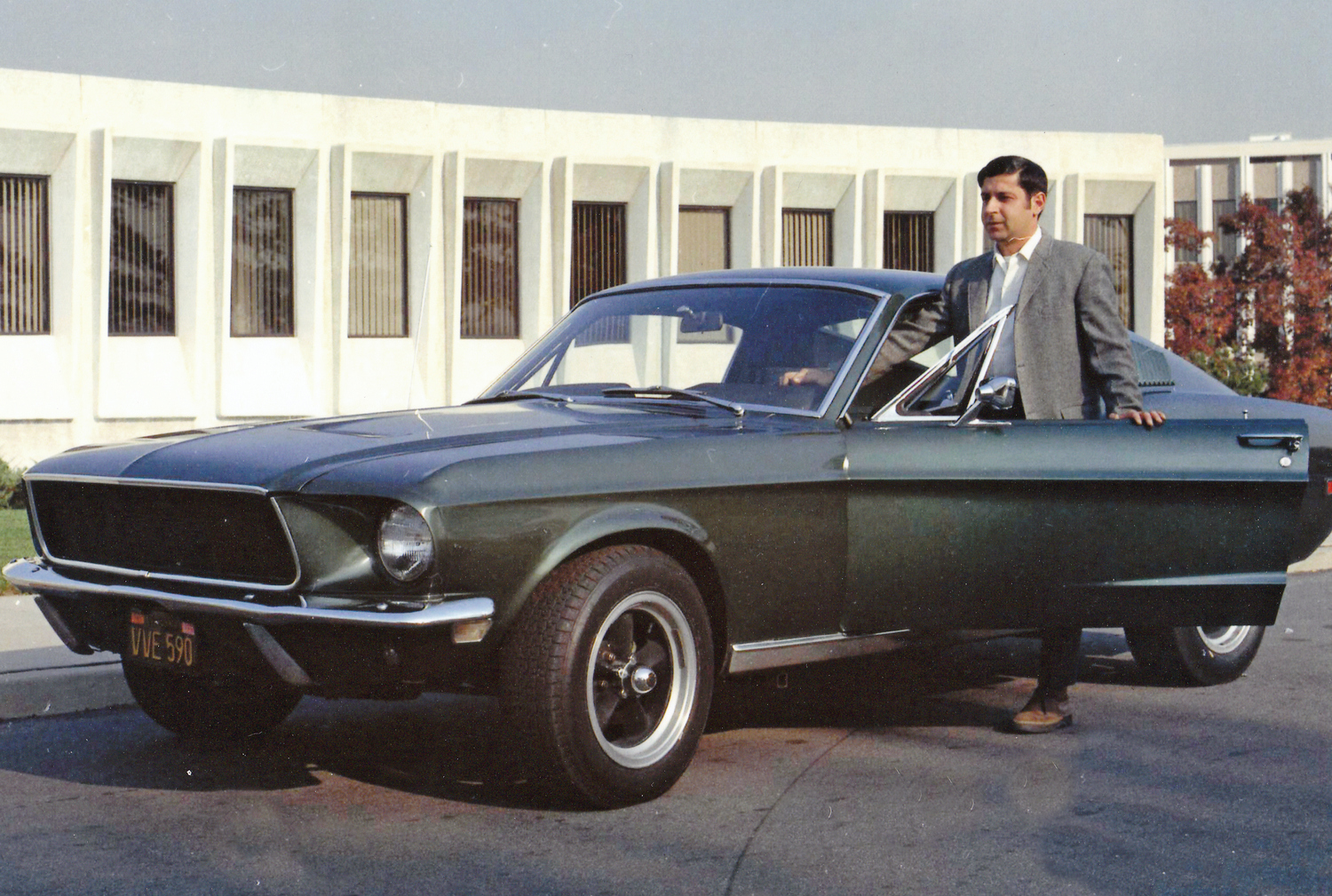
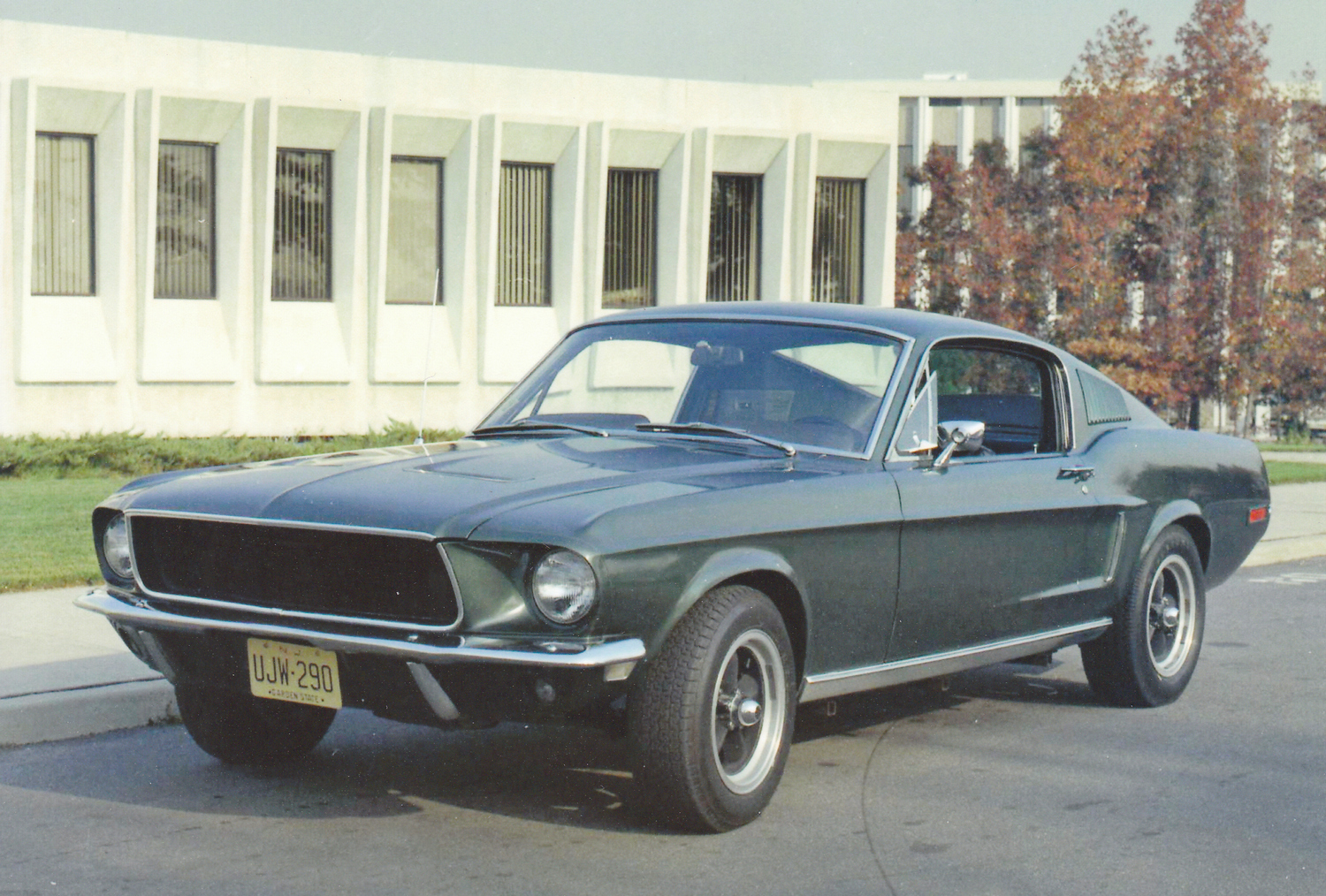
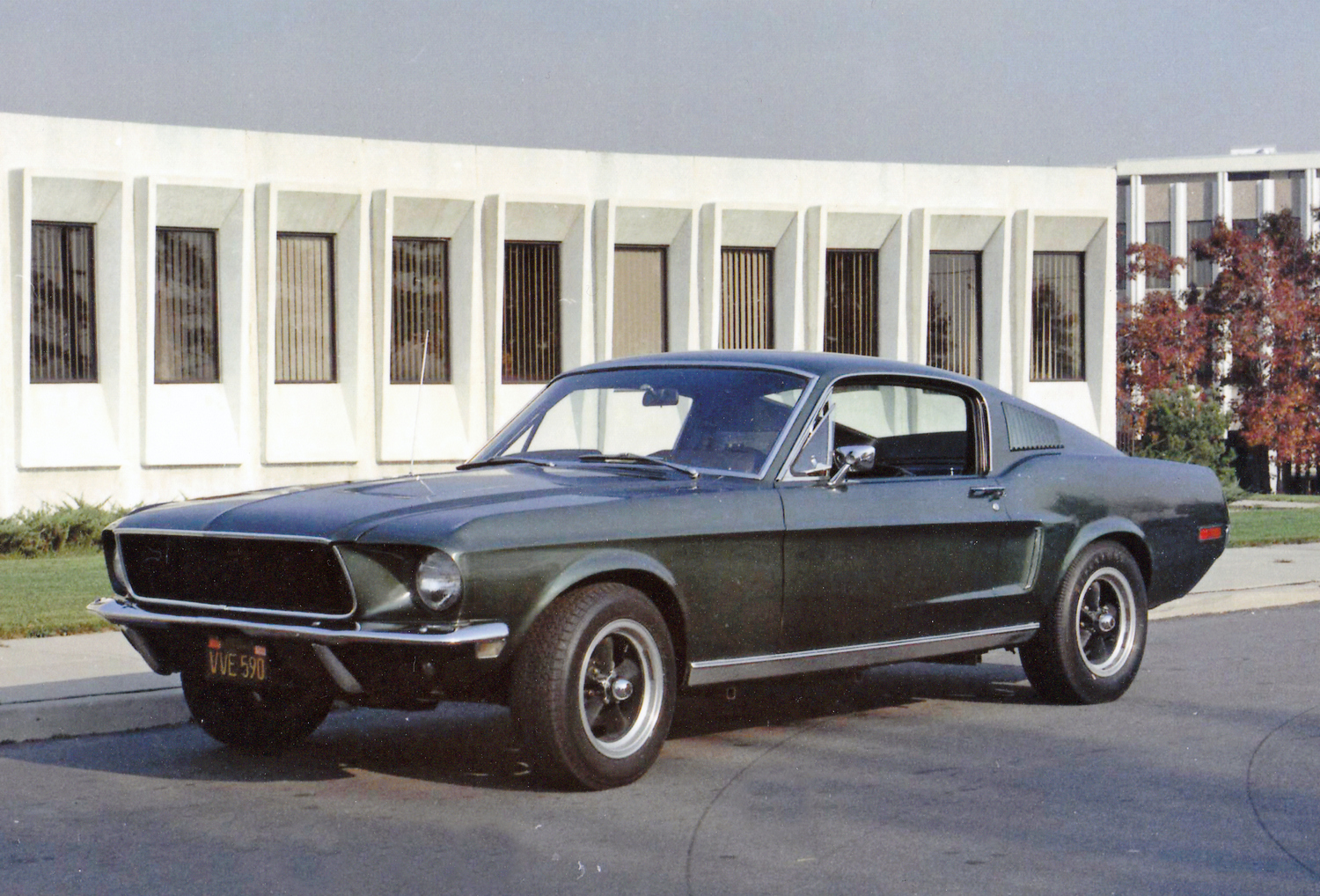
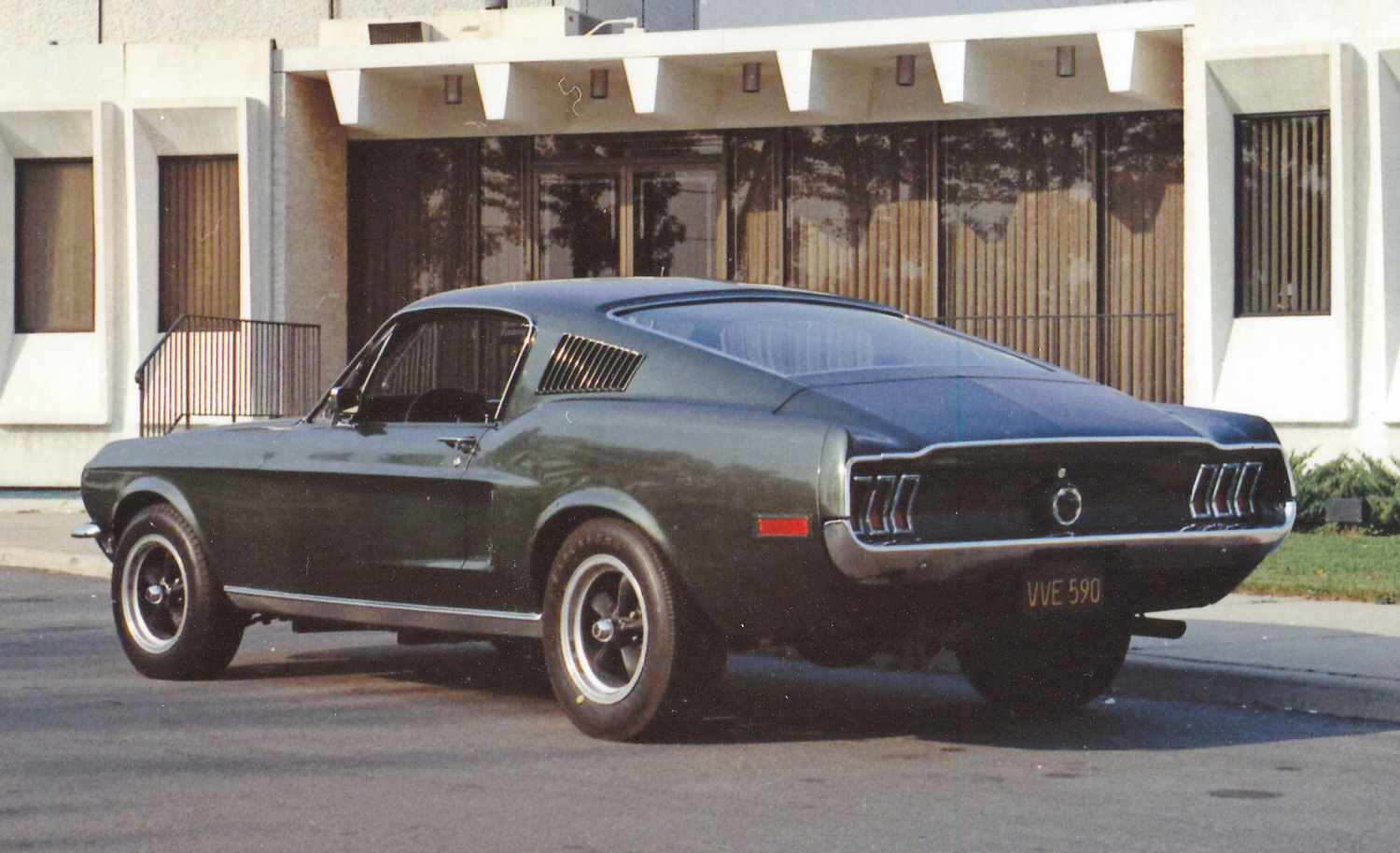
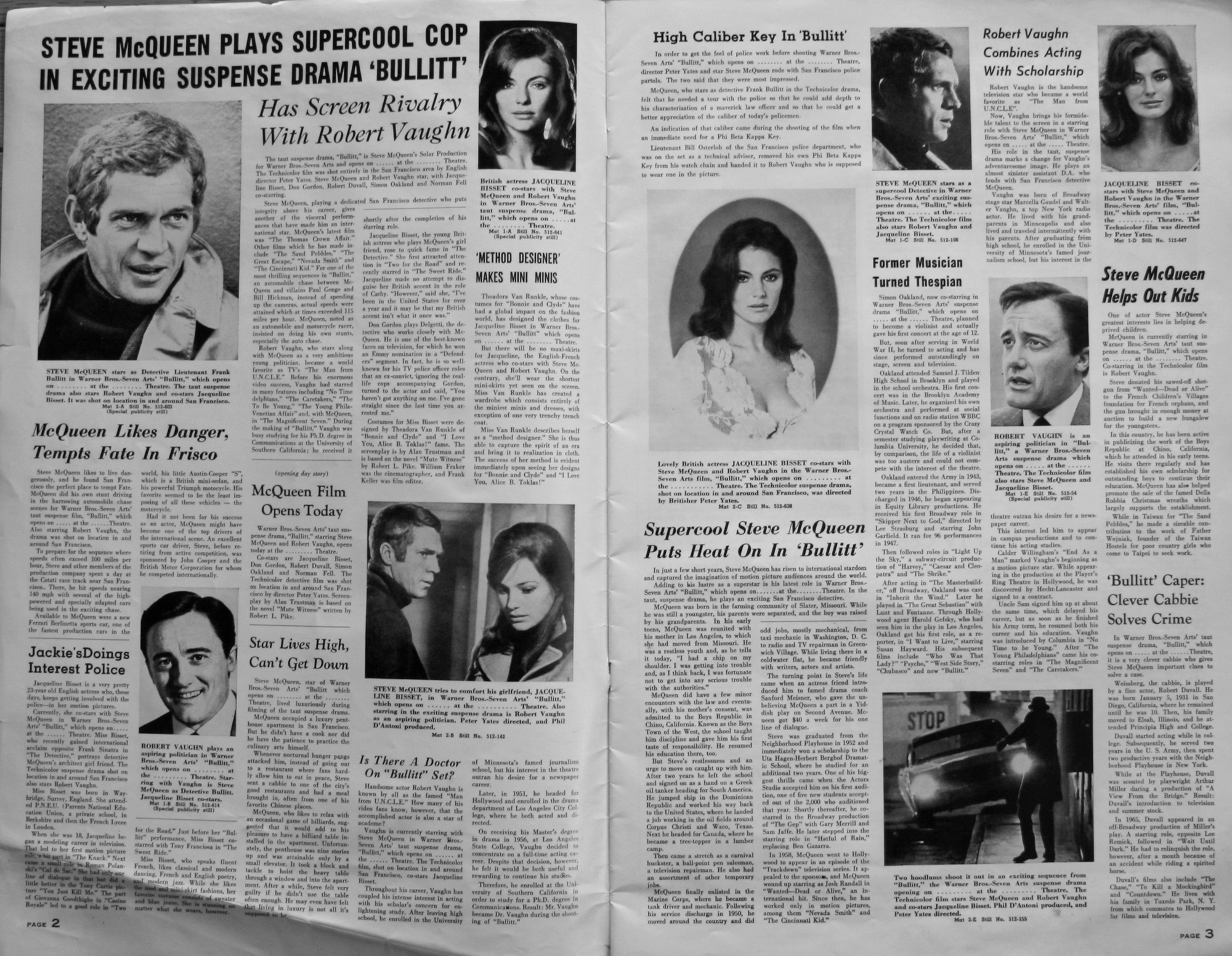
BOWLING: How many times did you see Bullitt before deciding that you wanted to own that very car?
MARRANCA: Twice. My first wife’s father worked at CBS News, and he used to show films at his house. He had something like a studio upstairs where we would watch first-run movies. That’s where I saw Bullitt for the first time. A friend of his worked for a film company, and he brought these big reels they would use in movie theaters. I mentioned to him once that I would love to own the car Steve McQueen drove in Bullitt.
He flew to California a lot with his job, so he heard the Mustang was for sale and told me. He gave me the number. That was on the weekend. Come Monday morning, I called Robert Ross.
BOWLING: Had you owned any high-performance cars prior to this one?
This is the list of features Robert Ross wrote to describe Bullitt #559 when he offered it for sale. Property Frank Marranca
MARRANCA: When I was in the Marines, I bought a ’65 Pontiac LeMans convertible, then later a ’65 GTO. I kept that for a few years, picked up a ’62 Corvette, which I sold for a ’67 Buick Riviera Gran Sport. Then came the Bullitt Mustang.
BOWLING: Was the sale contingent on Ross verifying that this was the actual car from the movie?
MARRANCA: I was convinced, just by talking to him, but I wasn’t going to release the money until I saw the car and the paperwork he had sent me. How we worked it out was…he would put the car on a train and ship it through the rails. I would deposit the money in the bank. That money would not be released to his bank until I looked at the car to ensure the car was in substantially the condition he described. He put the car onto the rails on Nov. 10, 1970, and sent me this paperwork that you see here. I went down to Southern Pacific on Dec. 4 to pick it up.
This is a letter from him. It’s handwritten in their [Warner Bros.] envelope, postmarked the 18th. In that, I have the original bill of lading, and there is the location where it was sitting in Staten Island. A copy went along with that, and when I picked the car up and authorized the release, I signed for it here, and I had to pay $356.16 [for the transportation].
Robert Ross wrote Frank Marranca a note about the care and feeding of #559. Property Frank Marranca
BOWLING: How much did you pay for the car itself?
MARRANCA: Six thousand dollars.
In the car was the original registration from him, from California. This is the letter of authenticity. This was also in the car – a list showing what was done to the car and how much money they approximately spent [getting it ready to be in the movie].
Also in the car were these photo cards. They would be put inside the movie theater to show what was playing, and this Pressbook was with it.
In an envelope marked “to whom it may concern” was a paid itemized bill for Warner Bros. After shooting the movie, they had Precision Auto Body on Hollywood Boulevard make some repairs to the car. The job cost $920.16 and was finished on Sept. 27, 1968. It included replacing the grille, grille surround, molding, antenna, a knob of some kind (for $4.65), and several other things I can’t make out from the handwriting. They also straightened and rechromed both bumpers – all for less than $1,000! Can you imagine how much that would cost today? One thing I didn’t get with the car was the shift knob. Somebody had taken it off the car before I received it in Staten Island. That was missing.
In the movie, my car had a small round mirror on the driver’s door. [It was painted body color.] I also see round mirrors on some of these replicas people have built, but when I got the car, it had a square mirror.
BOWLING: What condition was the car in when you got it?
MARRANCA: There were no dents, scratches, or rips in the interior. It was a used car, you could tell, but in very good condition.
So, you've bought a world-famous Mustang. How do you get it to New Jersey from California? Frank Marranca had it shipped out by rail. Property Frank Marranca
There was a small piece of tape on the tachometer when I picked it up from the train station. It had the words “little pieces” written on it in pen. It was pointing somewhere between 7,000 and 8,000 RPM. As pre-arranged, I called Ross to tell him I had the car. When I asked about the sticker, Ross told me that McQueen or [car builder] Max Balchowsky had placed it there so McQueen would stay out of the engine’s redline. Going over would blow the engine to “little pieces.”
The only thing I’m aware of that was altered was that they took out the insulation from the firewall so the noise of the engine would come into the driver’s compartment. They had truck mufflers with straight pipes.
Property Frank Marranca
If memory serves me, Ross told me that in the trunk, on the left-hand side, there’s a hole and a piece of tubing in there. He told me he thought there had been a blower on there to keep the brakes cool. However, I’ve read lately that it may have been a vent for a generator to keep the camera cool. I don’t know which is true.
One of the first things I did to the car was take it to Roger’s Speed Shop in Garwood, on South Avenue. Roger Munn put a four-speed Hurst shifter in there. Not long after that, I took it to a place in Elizabeth called Cleveland Auto & Tire on 3rd Avenue. They put Pirelli racing tires on.
I’ve read something about a Nardi steering wheel being taken off. I don’t know anything about that. The steering wheel that was on the car when I bought it is the same steering wheel that was on it when I sold it.
I had a kill switch installed, but I don’t remember who did the work. That kill switch was inside the ashtray. When you lowered the ashtray, you pulled out the insert where you would put your cigarettes, and there was the switch. I’ve read somewhere mentioned there was a switch they thought was for fog lights – I don’t know if they are talking about the same switch I’m talking about. Those are the only two things I did to that car.
The first summer I had the car, my wife and I went down to Wildwood, New Jersey. It’s a seashore town. We stayed at a hotel on the Wildwood Crest. I engaged the kill switch, and I took the coil wire with me. I was still looking out in the middle of the night to make sure the car was where I left it.
BOWLING: Why did you put in a Hurst shifter?
MARRANCA: I didn’t like the four-speed shifter that was in there. It felt sloppy. It made a big difference – much tighter. As for the tires, I had gotten a flat with the Firestones on there.
BOWLING: Did you keep it a secret that you had the actual Bullitt Mustang?
MARRANCA: No. I made no bones about it. If anybody asked me about the car, I told them what it was. At that time, nobody really cared.
Here is the repair order for the work performed on #559 before it was sold to Robert Ross at Warner Bros. Property Frank Marranca
BOWLING: Did you keep all of the car’s original markings and decals intact?
MARRANCA: Back then, the New Jersey Dept. of Motor Vehicles put its inspection sticker on the passenger side of the windshield. Near that spot, the Mustang had a sticker that was about ¾ of an inch wide and two inches long that said “WB,” which I suspect was the Warner Bros. sticker that allowed Ross to drive the car on their lot as an employee. It was all the way in the bottom of the glass, and I wanted to keep it intact. You could not see that sticker from anywhere inside the car. You had to be outside the car, looking in, to see it.
The DMV in New Jersey said it was obstructing my vision, and they failed me. I pointed out that I couldn’t see it, but I could see their sticker, which was above it. I had to scrape it off, but I could not get all the way into that corner to remove it. They refused to scrape it off themselves. They put a “failure” sticker on. I went home, scraped off their failed sticker, put the California plates back on, and drove it like that.
The following year, I put the Jersey plates back on, took it in for inspection and they gave me a hard time because I scraped their sticker off. They threatened to call the police on me until I explained that I was the police.
BOWLING: It must have been a blast to own the honest-to-goodness Bullitt Mustang. Tell us your favorite memories of your time with it.
MARRANCA: In 1971, Bullitt was playing at the Linden Movie Theater on Wood Avenue. I spoke to the manager and asked he if wanted me to bring the car over on a Friday night. He gave us six free tickets. The car sat outside. Some people showed interest in it. Other people didn’t even notice it, just walked right by it.
Here is my article in the April 2010 issue of Mustang Enthusiast magazine. The text of the interview is reprinted here. Property Brad Bowling
BOWLING: Were people aware it was the car – not just a green Mustang?
MARRANCA: Some were. I thought they were going to announce it, but they never did. Some of the people I worked with had never seen it before, so they went over to look at it.
At one time, back around 1972, I was assigned to the Narcotics Strike Force of Union County. We had no real undercover cars in the beginning. They were usually unmarked police cars painted different colors. We had a case involving an individual from Mountainside, New Jersey, who allegedly was going to Newark to purchase drugs. I took the Mustang one day, and a couple of other guys in different vehicles followed the car to Newark, where we watched him make his purchase and drive back to Mountainside, where we arrested him. It was fun getting to drive it on the highway.
My wife and I, one Sunday morning, were going to Atlantic City on the Expressway. It was November, and it was cold. A Datsun pulled up next to us and obviously wanted to race. The speedometer was showing 120, and the tach was still rising. I left him in the dust. I never did downshift; I just opened the four-barrel. That was the fastest I ever drove the car. I normally just drove it on the highway.
Frank Marranca, when I interviewed him in 2009 Property Brad Bowling
It was always kept covered in a garage. I would take it out on weekends and drive around with it. It was quite a car to drive, it really was. When I drove the car, it was very tight. When taking corners – like ramps on the parkway – the car didn’t lean. It just sat there. I never tried to smoke the tires or burn rubber, but it was a very strong-running car. When you rode in that car, you knew there was something fast under you.
I had police cars that didn’t have that much power. I had a ’74 Plymouth 440. It was probably the fastest police car I had. If I remember right, it had 160 or 180 on the speedometer. That Plymouth was a monster on the highway. It would just gobble the highway up, but nothing ran like that Mustang that I ever drove.
BOWLING: Was it loud?
MARRANCA: Yes, it was. One time, it failed my DMV inspection because it was too loud. The next time I took it back, it passed, even though I had done nothing to it.
BOWLING: It sounds like you really enjoyed owning it. Why did you sell it?
MARRANCA: My wife at the time said I was being selfish having it in the garage. She had a three- or four-year-old Chrysler station wagon, and she wanted a new wagon. I sold the Bullitt car in April of 1974 and bought a new Chevy Vega station wagon. When I sold the car, it had about 19,000 miles on it. I don’t remember how many miles it had when I bought it, but I doubt I put more than 10,000 miles on the car.
BOWLING: How did you go about selling it?
MARRANCA: Road & Track, if I remember right. I put an ad in. I sold it for what I paid for it – $6,000. The car was already six years old. The guy who bought it was the only one who called. When I sold him the car, I gave him some of the paperwork that had come with the car. I kept a lot of it. He never asked me for it. I gave him the California license plates that were on it when I bought it. I remember standing in the middle of the street when he was driving away, thinking, “There goes my car.”
I can picture myself standing there now, watching it go away. It was like somebody stole my car.
Steve McQueen contacted Frank Marranca three years after Marranca sold #559. Property Frank Marranca
BOWLING: A few years later, Steve McQueen was trying to locate the car, but you had already sold it. How did he find you?
MARRANCA: I was working sex crimes in 1977. I had come in off the road, and there was a phone message to “call Mr. McQueen.” I called the number. I had no idea who it was, because we would get calls from all over the United States concerning cases.
The girl answered the phone: “Solar Productions.”
I said, “Detective Marranca for Mr. McQueen.”
She said, “Oh, you’re the detective who has the Bullitt Mustang.” I remember taking the phone from my ear, looking at it, and putting it back to my ear.
I said, “Steve McQueen?” I felt like a little kid, you know?
I gave them the information to find the third owner. They called me back to tell me he wouldn’t sell the car. I still have that information somewhere. I haven’t looked that hard to find it, but back then I had a complete file of papers that included the contact information for the guy I sold it to.
They followed up by sending me a nice letter and an autographed picture. They sent that voluntarily; I didn’t have to ask for it. The ink on the photo is faded now because it sat in my office for 20 years until I retired.
That contact with McQueen was the last time anybody asked me about the Bullitt Mustang until you showed up.
THE THIRD OWNER OF #559
In this envelope, Bob Kiernan received a letter from Steve McQueen asking to buy back #559. Property Bob Kiernan Family
Bob Kiernan was 24 years old when he bought Bullitt #559 from Frank Marranca in 1974 for $6,000. During the first week of my communication with him in 1989, he provided several pages of documentation, including copies of the first owner’s card (registered by Bob Ross on Dec. 14, 1968, license plate VVE 590) and the latest (registered by Kiernan in his home state of New Jersey on March 7, 1978, license plate 850 IPZ). Both cards gave the vehicle identification number as 8R02S125559, which matches the number from the Warner Bros. letter. (Years later, Kevin Marti of Marti Auto Works verified for me that this car and its twin, VIN 8R02S125558, were initially shipped to the same office in Southern California as other “movie” Fords.)
Kiernan told me in 1990 he had not actually seen the car in almost six years because it was stored in his father's garage in New Jersey, several states away from where he was living in Kentucky. He was surprised to hear that his car had been the source of such speculation. Kiernan was not a hardcore Mustang enthusiast and told me his interest in the car was a combination of the low asking price* and the fact that a major movie star had driven it.
His anecdotes about driving the car back up Bill Norton’s stories about it being a real handful and noisy at any speed. In fact, during a rainstorm, Kiernan did some Frank Bullitt-style driving when he lost control of the fastback and slid 360 degrees around, resulting in some minor body damage.
According to my earliest phone conversations with Bob Kiernan, he had made no changes to the car and, in 1990, he told me he thought it had approximately 40,000 miles on the odometer.
“Otherwise,” he told me, “the engine compartment, interior, and paint all look original.”
Despite the fact that he wasn’t driving it any more, he insisted it would never be for sale.
* I never understood why Bob said "low asking price," when $6,000 would have bought several 1968 Mustang fastbacks in 1974. My theory is that Bob spent so many years away from the Bullitt car that he forgot how much he paid for it.
1997 Contact with Bob Kiernan
Here is (left to right) Chad McQueen, John Clark Gable, and Brad Bowling having dinner at a restaurant in Malibu in 1997. A friend told me I would someday regret making a funny face for this picture. I now see what he was talking about. Property Brad Bowling
I tried to bother Bob Kiernan and his family as little as possible during the next 28 years. Every few years, a magazine editor would ask me if there were any updates to report. I also received a lot of calls from people wanting to reach Kiernan, but I only called him if I thought it might change his mind about revealing the car to the public. I had become the Bullitt version of Jimmy Olsen—people sought me when they wanted Superman.
When I met Steve McQueen’s son Chad in 1997 while visiting my friend John Gable and his girlfriend Lex in Malibu, Chad asked me about the car. I showed him Kiernan's paperwork (while maintaining the owner's anonymity, of course) and Chad became enthusiastic that something could be done to get the car into the open. I phoned Kiernan and discussed possibilities Chad had raised—such as the McQueen family buying it and promising that no one would reveal the owner’s name or whereabouts—but I could not move him from his position.
1998 Contact with Bob Kiernan
A year later, I called him at the request of the Petersen Automotive Museum in Los Angeles, which was celebrating Bullitt’s 30th anniversary with a special exhibit of period clothes and movie memorabilia. Hoping against hope to borrow #559, my contact at the museum even offered to have board member Jay Leno phone the owner. When I reached Bob Kiernan, he did not want to discuss #559, which he had relocated twice in the 10 years since our first talk. It had been stored in his father’s garage in 1990, before being moved to the Kiernan horse farm where it spent eight months in a barn. While there, a worker on the property told a Mustang enthusiast about a hidden green fastback that had a history. From the description, the Mustanger suspected it was the Bullitt car and snuck onto the grounds to take some pictures without permission. I later learned that the car's air cleaner was stolen at this same time. Kiernan told me he had dealt with the employee who allowed this to happen, then moved the car to the garage in his Tennessee home, where it was sitting next to his Porsche as we talked. He thanked me for keeping his identity a secret but once more declined to consider any offers to show the car. The Petersen built its display around Dave Kunz’s popular and very accurate replica of the movie car.
2000 Contact with Bob Kiernan
On May 1, 2000, by sheer chance, I happened to call Kiernan on the day of his son Sean's 16th birthday. Someone had put a proposal in front of me that I thought might influence Kiernan to reconsider his position. He told me I was no longer the only person who knew about the car because the producers of the first Charlie’s Angels movie had tracked him down. It seems Drew Barrymore wanted her character to drive the honest-to-goodness Bullitt Mustang.
This exchange did not sit well with Kiernan because, in his words, “They would not take ‘no’ for an answer!”
According to Kiernan, the producers called him at home and at work and even sent gifts to his house in an attempt to change his mind. Their offer grew to include money, a trip to Hollywood, and dinner with Ms Barrymore. Kiernan, whose privacy is quite precious to him, finally threatened the movie makers with legal action if they did not stop bothering him. *
He said he was dedicated to keeping the car’s existence secret because his son wanted to “clean it up and start driving it now that he’s getting his license.”
Before I let him off the phone, Kiernan promised he would consider showing the Bullitt car to the public if and when an official Mustang museum was built.
“Otherwise,” he declared, “it’s staying in the garage!”
That was the last time I heard from Bob Kiernan.
* To be honest with you, my notes are vague on exactly when the Charlie's Angels talk took place. It is very likely that we discussed this during our 1998 phone conversation. Considering that the crew for the 2000 movie would be buying or renting its cars for filming as early as 1998, the producers' phone calls to Bob were probably something we talked about in 1998. Sorry to be confusing on this point, but the exact timing is of minor significance.
MARCH 1, 2001 -- BULLITT SCRIPT PAGES
Would Bullitt have still been Bullitt without the Mustang and Charger? Silly question! Property Mike Magda
Fellow auto writer Mike Magda contacted me in 2001 to talk about a Bullitt article he was writing. He promised to share some pages from a movie script he had acquired that shed some light on early thinking about the chase scene. From pages 35-37* of a script dated Dec. 4, 1967, I got to see the dry description of what would become a legendary set piece. There is no mention of a Mustang or Charger. Instead, bad guys speed away from a hospital in a black Buick, while Frank Bullitt jumps in a police car to give chase. There are no keys, so the detective commandeers a Mercury sedan. Instead of a fiery gas station crash, the chase ends in a watery death for the Buick's driver, and the passenger manages to escape. As a sign of just how early this version was in the production process, notice that there is a character named "Frank" and another named "Bullitt." Bullitt's first name had not become Frank yet.
* It is noteworthy that the chase in this early draft of the script starts on page 35. A two-hour movie script is usually around 120 pages (or one page per film minute). Bullitt ran 113 minutes from start to finish, with the famous chase occurring closer to the two-thirds mark.
JUNE 12, 2007 -- BULLITT PODCAST
During a roundtable interview for a Bullitt-oriented podcast for themustangsource.com, Dave Severin of Columbia Pictures told me (and the audience) that he had also tracked down #559 and verified that we had been in touch with the same third owner. Brad Barnett was the host of the discussion, and Dave Kunz was the third panelist for the talk.
UPDATE (Feb. 7, 2018) -- Anthony S. Alonso contacted me to offer both parts of the Mustang Source podcast. My discussion is in the second part below. Anthony knows a thing or two about Bullitt Mustangs, since he has just co-written (with Scott Hoag) the book Engineer + Enthusiast = Excitement: Building the 2001 Bullitt and 2003/04 Mach 1 Mustangs. E+E=E will be available for pre-sale shortly through this link and should be in hands by this summer.
JUNE 2010 -- FRENCH TELEVISION
On June 11, 2010, French journalist Stéphane Munka visited my home in Concord, North Carolina, to interview me for a documentary he was producing about the Bullitt Mustang and America's car culture in general. Here, you can watch my portion of the film.
AUGUST 2015 -- MIKE MARCHIO INTERVIEW
In August 2015, I received an email from one of Bob Kiernan's friends, Mike Marchio, asking if I had heard any news about #559's owner. I called Marchio, who provided 45 minutes of his time for an interview.
He started by letting me know that Kiernan had been struggling with a chronic disease for a decade, and he passed away in 2014. Marchio had only spoken to Kiernan a few times over the final 10 years of Kiernan's life and was prompted to contact me when he saw an old article I wrote for a magazine. (He couldn't remember which article.)
Marchio spoke to me from his memory, and he noted several times that he might be remembering a few things wrong after so many years. I am reporting his comments here, because they come from someone who drove and rode in #559 from 1974 through 1980. According to Marchio's recollection...
Marchio told me that Kiernan was "anything but a recluse" when he bought #559 in 1974. Kiernan drove #559 as his everyday car until 1980, when a job transfer relocated him from New Jersey. Marchio and his wife rode in #559 many times with the Kiernans. Marchio drove #559 many times.
"It was referred to as the 'static car.' It had been repainted a number of times, and not very well. It looked nice. The body was straight, but the movie studio must have dinged it up. It had a Hurst shifter with a big white knob on the top, which is different from what I read about the car when it was in the movie. The action on the shifter was fantastic."
"Bob was enamored with the Warner Bros. parking sticker on the windshield. It made him feel good about the car's authenticity. Back then, there was no Marti Report to verify this. The second owner had all this documentation to prove its history, including some audio tape the studio had made of the car's exhaust sound for the movie."
"What I remember, Brad, is not that the car was fast -- there were a million fast cars back then -- but it was really, really tight and incredibly responsive. The car had iron brackets welded underneath that were probably installed to hold cameras, but I think they helped with the stiffness, as well."
"It just wasn't a big deal when Bob got it that it was the Bullitt car. It was just slightly more interesting than having a regular Mustang. But it handled like a current foreign sports car. Whatever they did to that suspension was very different from stock. I had a 390 '68 fastback Mustang. It was like driving around in a bath tub compared to this car."
"After he had had it about a year, Bob had an accident with it. He spun out and smashed the ass-end into a tree. It was repaired by an excellent body shop in Summit, New Jersey. The car came out better after the accident. They painted it perfectly. He didn't get it totally repainted, but a lot of the repaired areas were in the rear."
"You made reference in an article to a hole in the trunk... a rotted area. I don't remember that, so that may have been covered up with a piece of metal. Bob raised Great Danes. He used to fold the seats down and put the dogs in there. There was no hole there that the Danes could have accessed. It was all carpeted like you would expect. It wasn't rotted out or anything."
"Can you imagine trying to put Great Danes in the back of a Mustang fastback? I wound up with one of their dogs, which is good because the car they drove when they weren't driving the Bullitt was an MGB GT!"
"Bob was more of a mechanical guy; I was more of a body guy. He had Alfa Romeos. He was always dealing with these GTVs and racing them. He knew cars. The only thing I remember him mentioning is that the Bullitt had something unusual with the distributor. I don't know if it had dual points... they didn't have electronic distributors then, but Bob said whoever set up the car had done something very effective with the distributor. From the outside, the engine looked dead stock. It didn't have a dress-up kit or anything."
MAY 2017 -- PUTTING TO REST THE "THIRD BULLITT MUSTANG" THEORY
After the discovery of Bullitt #558 in Mexico, a zombie of a theory has stirred back to life that there were three identical Mustangs used in the movie. I am here to put a flaming hatchet in that zombie's brain. (Or whatever one does to kill a zombie; I don't follow that genre.)
Since people enjoy a good mystery and treasure hunt, the three-car story has gained traction in social media during the run-up to the movie's 50th anniversary in 2018. There is no evidence to support this claim. No one I interviewed for my stories ever suggested there were three cars. Kevin Marti searched his Ford production database for a third Highland Green fastback that would have been delivered to the same California D.S.O and never found one.
So, why the memory of a third car?
I pored over 27 years of notes about #559, and I solved that mystery from scribblings on a piece of scrap paper. When I interviewed Robert Ross in 1989, he told me, "After I bought it [#559], the studio rented it from me for a day for some final shooting." We know that Warner Bros. refurbished #559, which returned the factory driver-side mirror and radio antenna (among many other body repairs), before selling it to Ross. The completion date on Precision Auto Body's repair order is Sept. 27, 1968. With Bullitt making its premiere just 20 days later (on Oct. 17), I doubt the cleaned-up #559 has much, if any, screen time. Perhaps it was simply photographed for marketing materials or for scenes in the "Making of" documentary or movie trailer.
However it was used, I suspect this rental Ross mentioned accounts for the recollection of a third Mustang.
JAN. 14, 2018 -- BULLITT #559 IS REVEALED TO THE PUBLIC!
Sometimes, it pays to annoy the right people.
In the summer of 2017, the chances for a #559 unveiling looked stronger than ever in my fanboy brain. The Bullitt movie's 50th anniversary was approaching. Word was getting around in the hobby that Ford Motor Co. would produce another hugely successful special-edition Bullitt, although Ford staff maintained their best poker faces when asked. I had not heard anything from Bob Kiernan's son, but, to place myself in his shoes, it seemed very likely that Sean would approach Ford with the idea of debuting #559 alongside the new 2019 Bullitt model. I made some phone calls, picked every brain in my network, and was finally told, "Stop asking. We can't tell you anything right now, but we'll make sure you don't miss anything!"
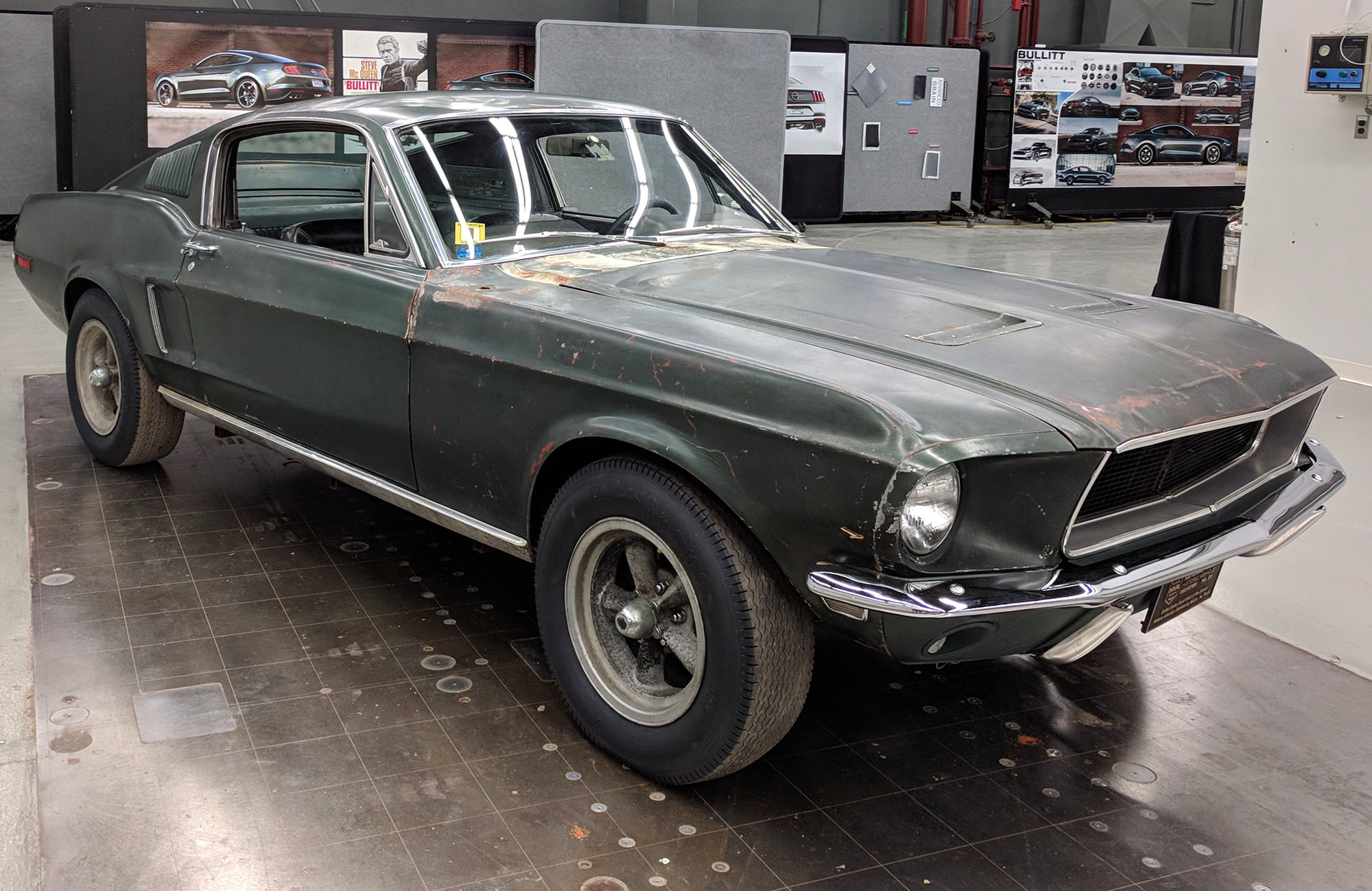
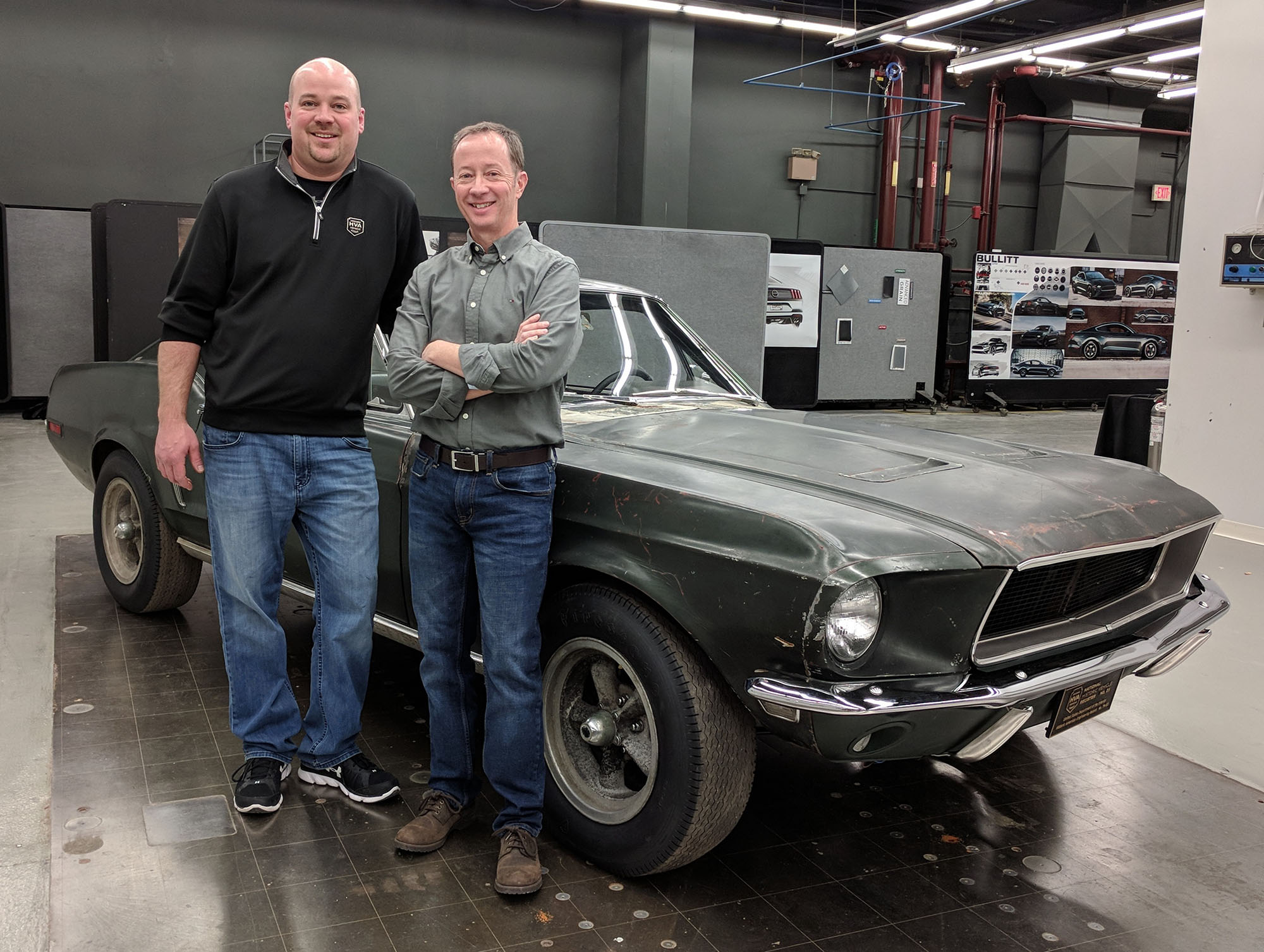
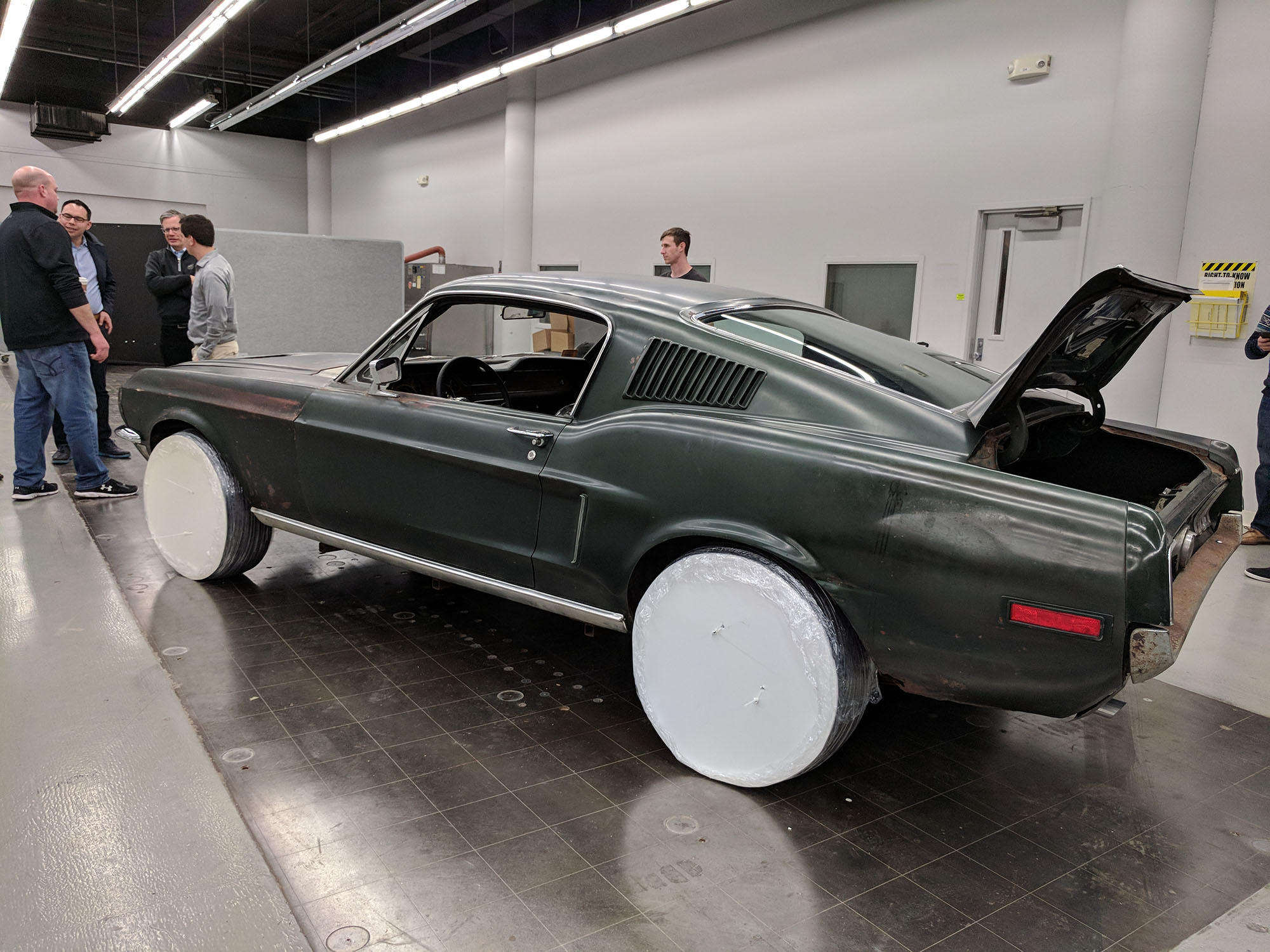

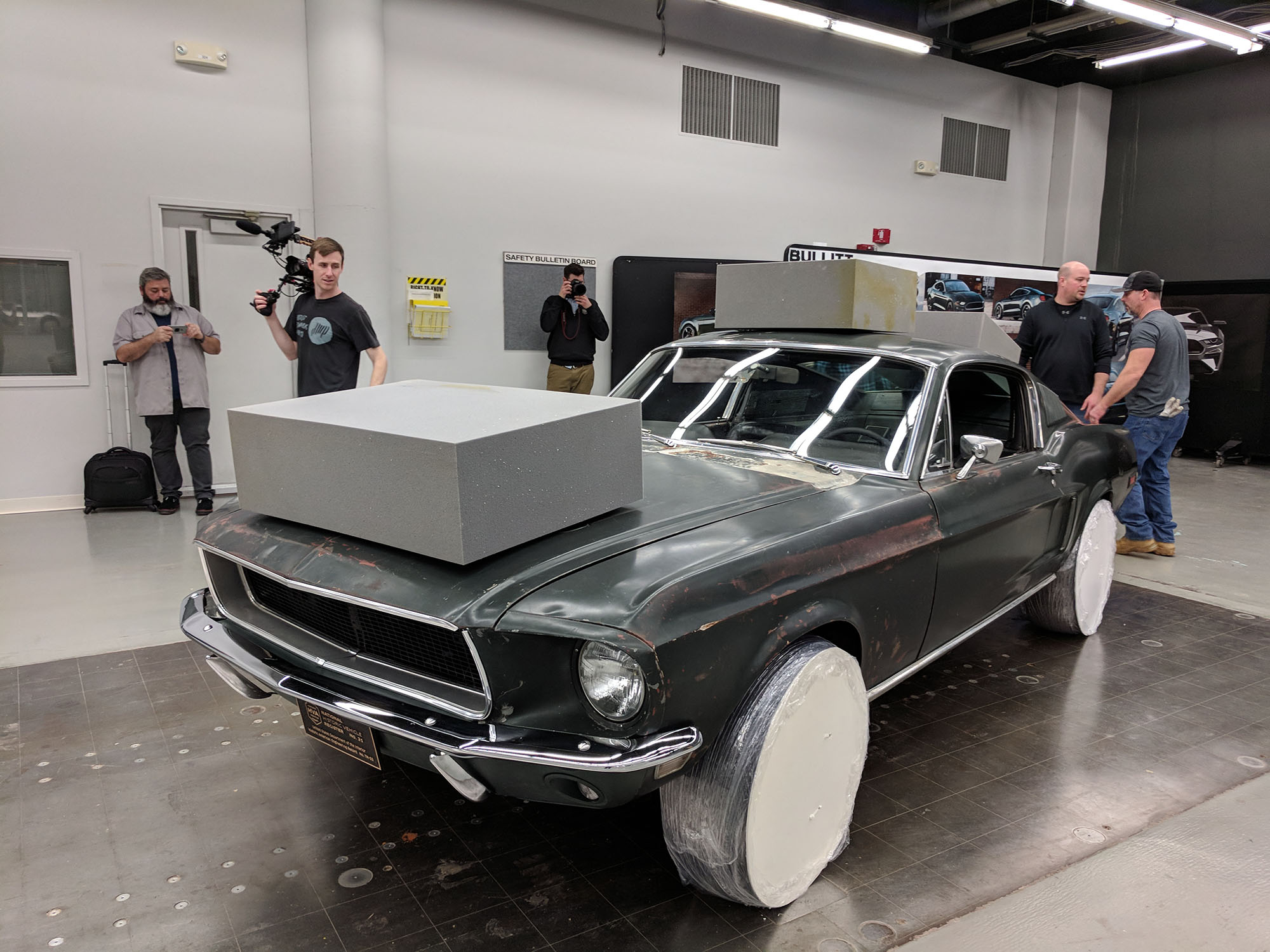
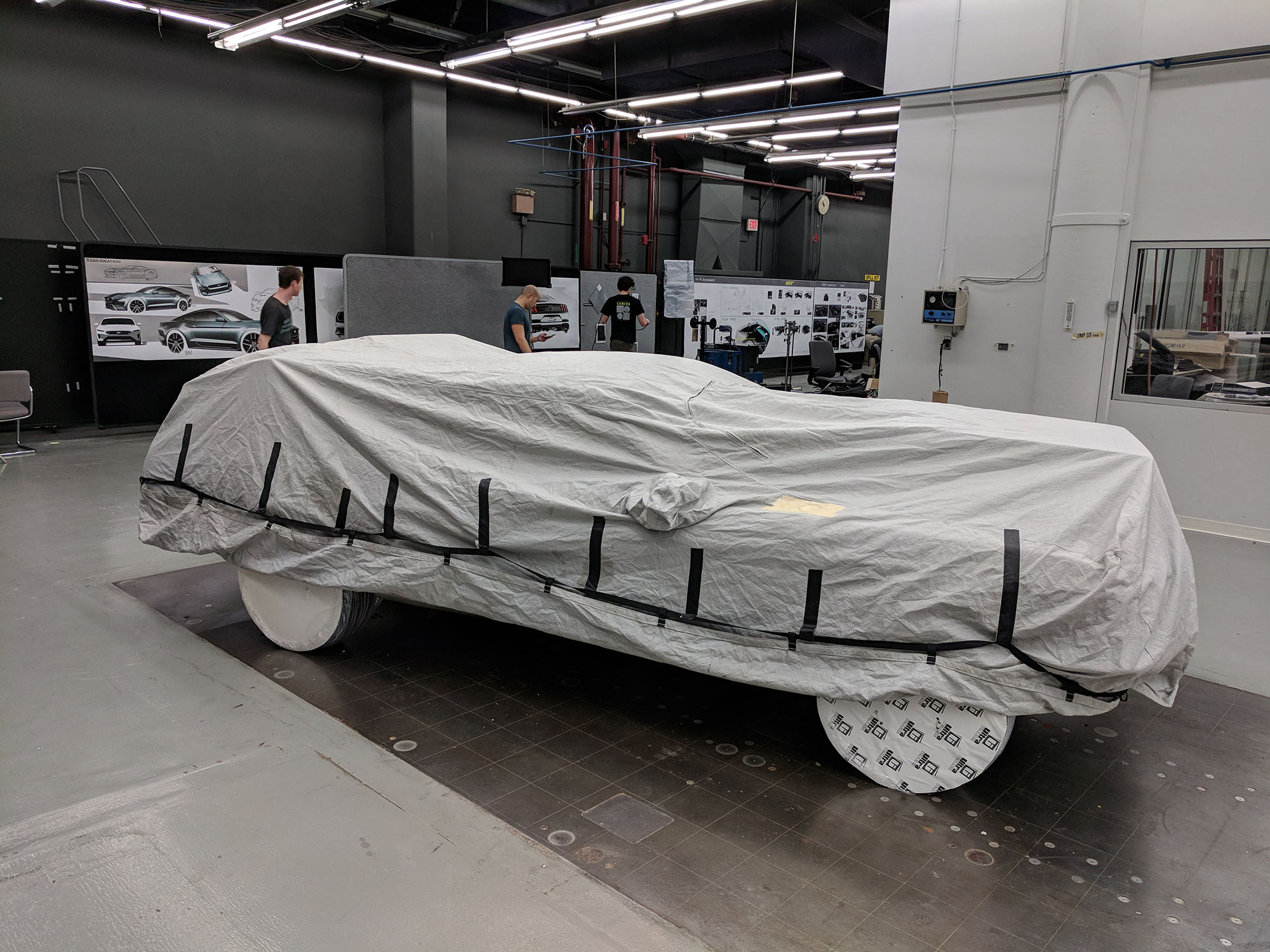
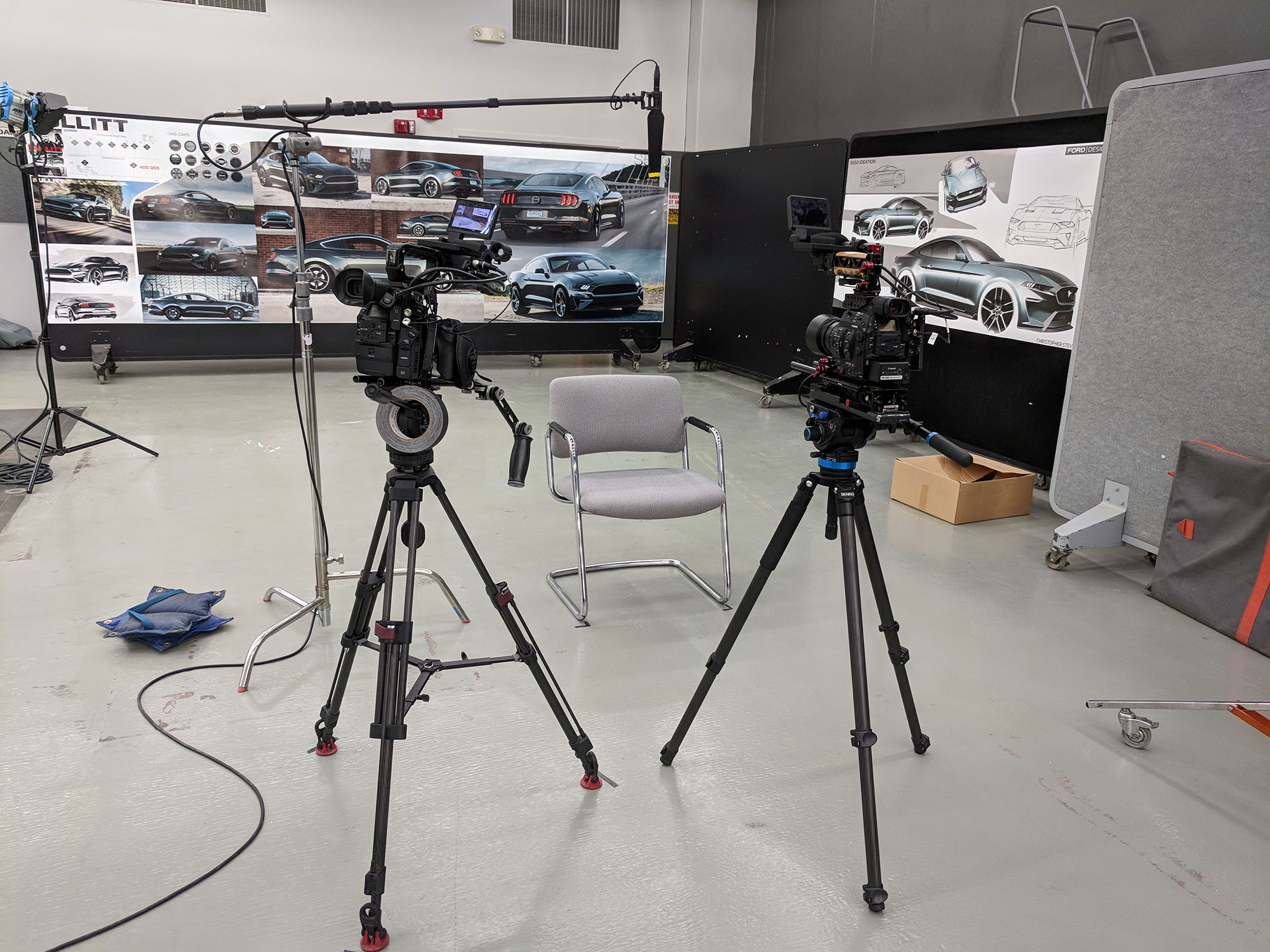
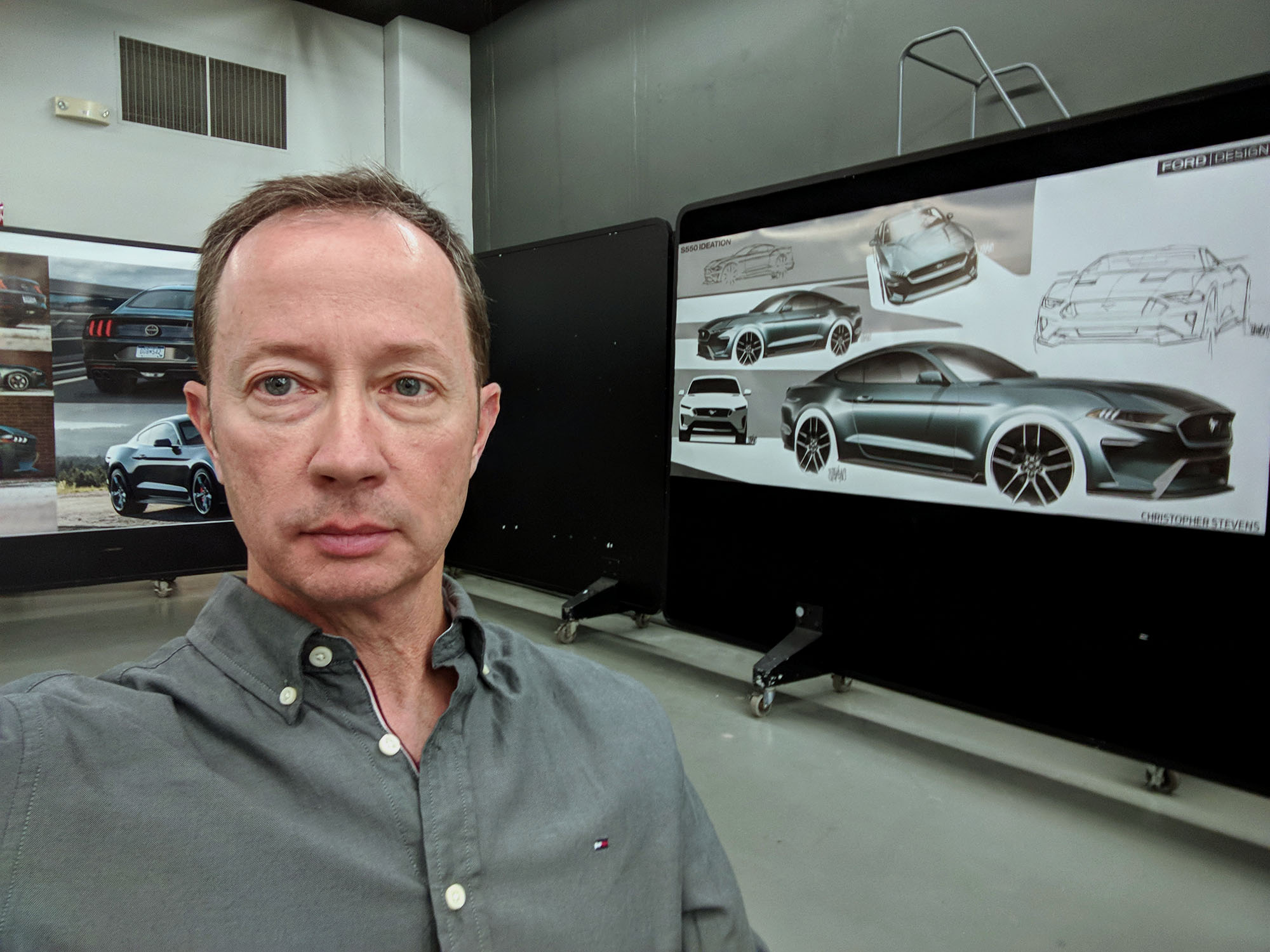
On Tuesday, Jan. 9, I got a text message asking if I could be in Detroit by Jan. 11. It also asked me to not tell anyone about the trip or what I expected to see. On Thursday at noon, a documentary film crew and I were ushered into a subterranean design studio. An elevator the size of a large room took us down to what looked like the coolest fallout shelter ever. Knowing this would be my first time to see #559 in person, the producer filmed my reaction, which was a combination of shock, joy, laughter, and a few tears. I talked to Sean Kiernan and we looked over the car while the cameras took it all in. We talked about my unusual relationship with his father and how much it had meant to me that he trusted me all those years to maintain his privacy. Kiernan showed me the work he had done on the engine rebuild; he said the 390 ran strong on the dyno. He pointed out the shiny new front bumper and explained that his grandfather had backed into the Mustang.
A crew from Ford and from Kiernan's group started building the camouflage cocoon that would help Ford get #559 into place at the Cobo Center for its big unveiling on Sunday. Because the 2018 Bullitt (which we now know is a 2019 model) was the worst-kept secret in Detroit, this crew went to great lengths to ensure that no one walked into Cobo on Sunday expecting to see a real Bullitt Mustang. (As of Thursday, I could find no social media chatter about such a reveal.) The wheels were covered with cardboard discs. The tires were wrapped with thick transparent plastic that would prevent the 1970s-era tire tread from showing. Blocks of a lightweight plastic were strategically placed on top of the hood and decklid. With an extra-large car cover thrown on top and tied, the whole package looked like a small parade float. The astonishingly gorgeous 2019 Bullitt, which I was allowed to see under the same confidential media embargo restrictions, went to the big elevator first, wrapped in a somewhat sexier, form-fitted car cover.
At Ford's invitation, I returned to Detroit on Sunday to be present for the 4:30 press conference in which both cars were presented to the public. A few paragraphs above are some smartphone photos I took in the bunker. I had my pro camera gear on Sunday to capture the excitement, shown below. After 28 years, I was excited to see the reaction the hobby had when #559 rolled across the stage, accompanied by its great-great grandchild.
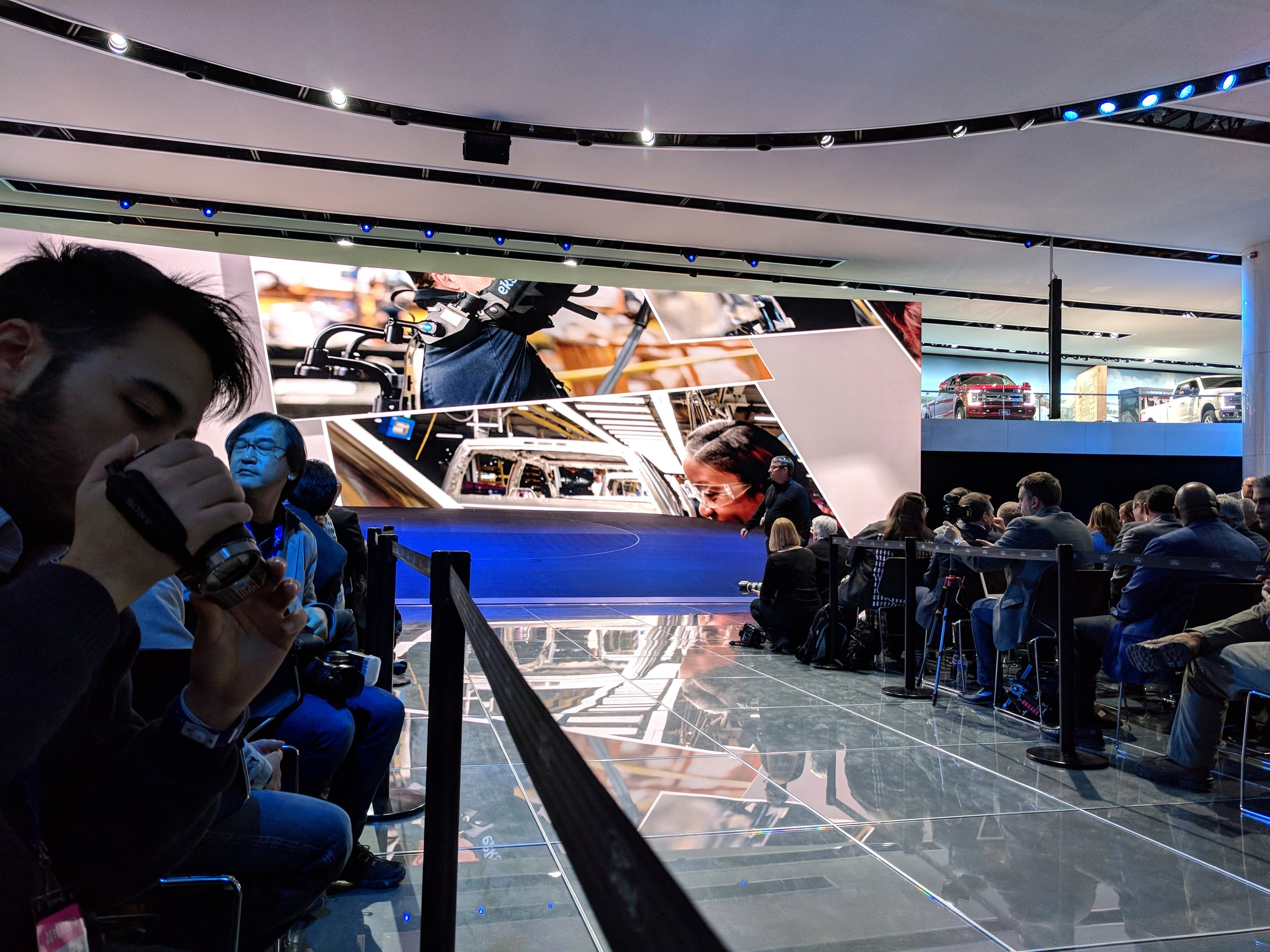
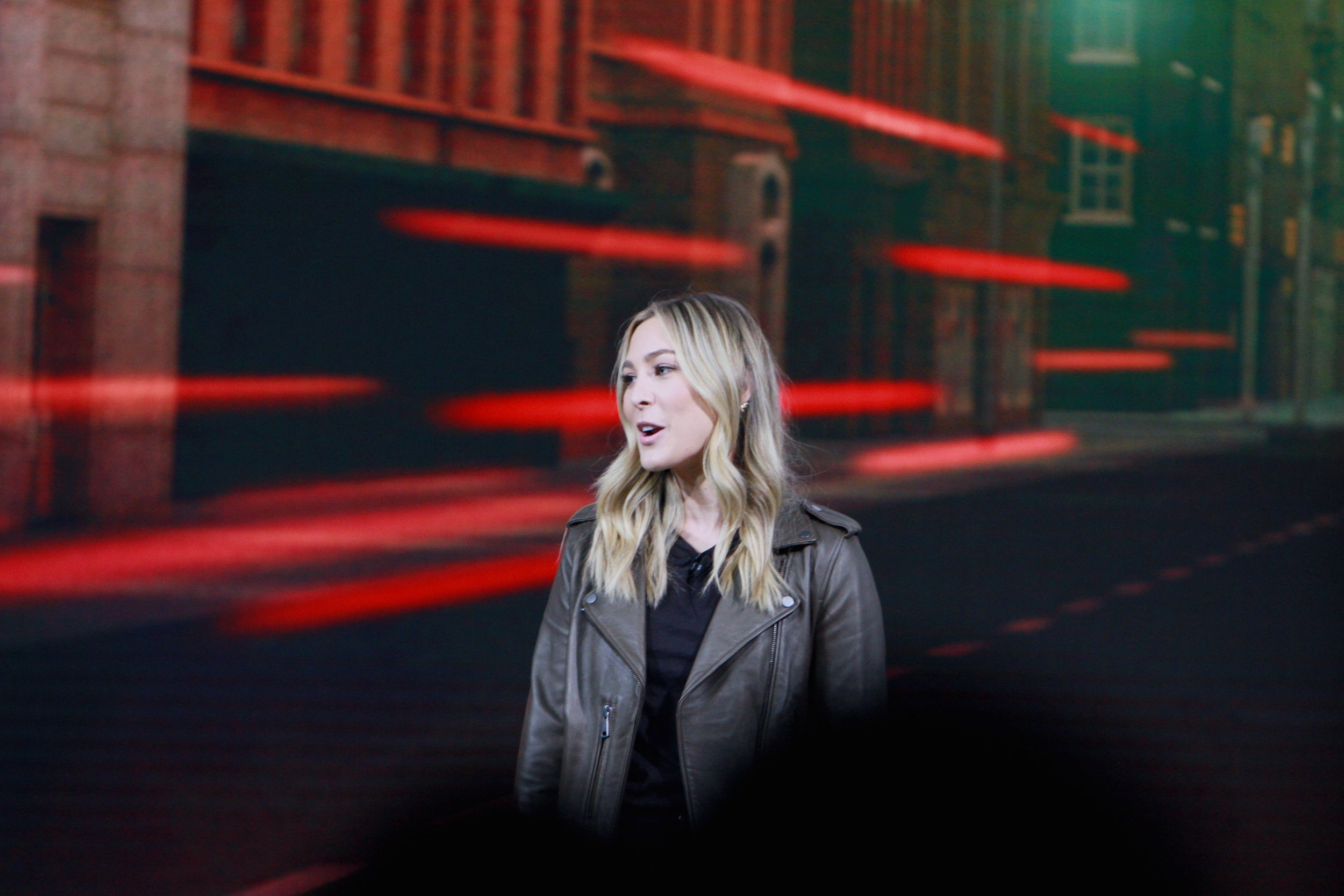
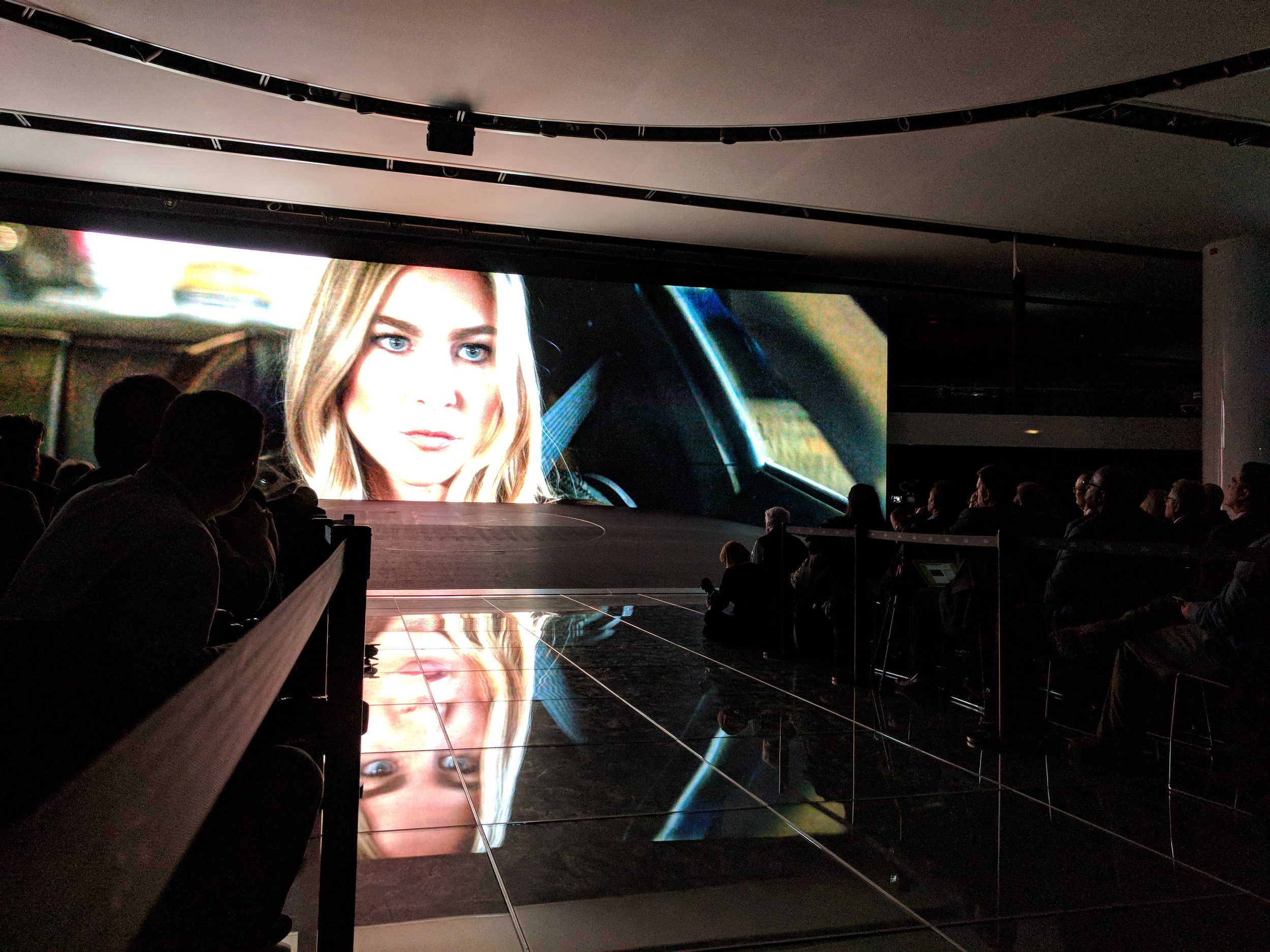
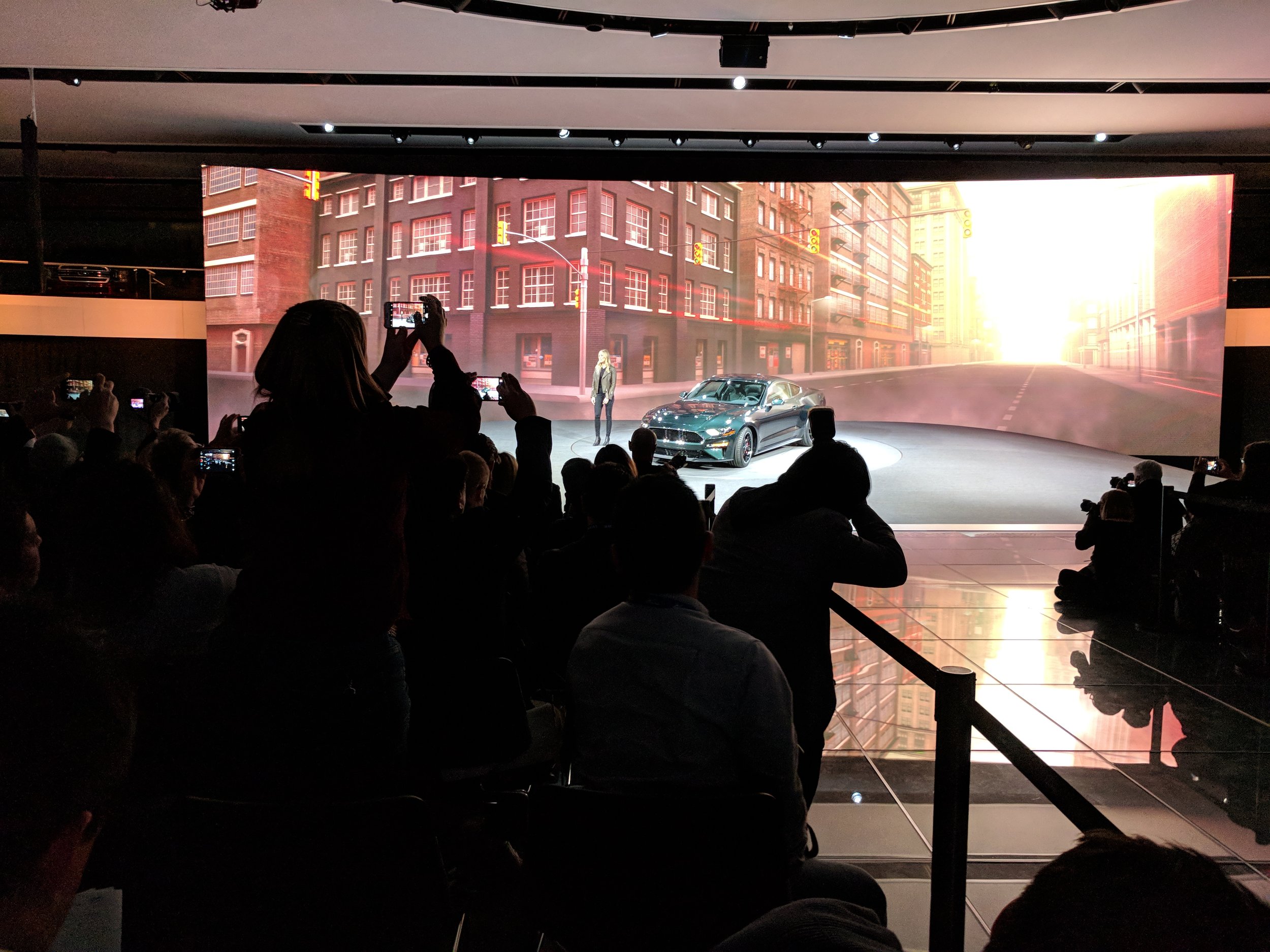
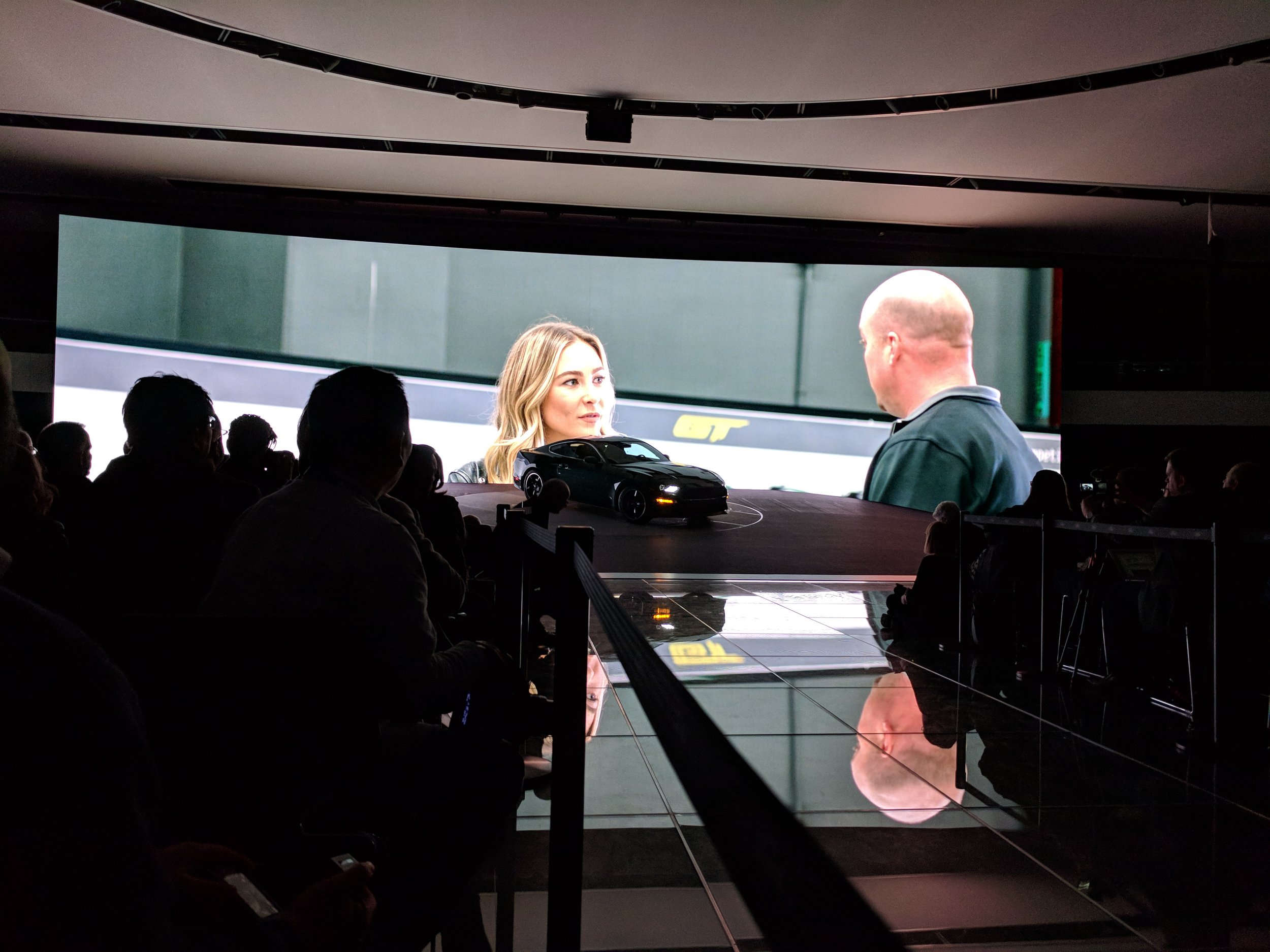
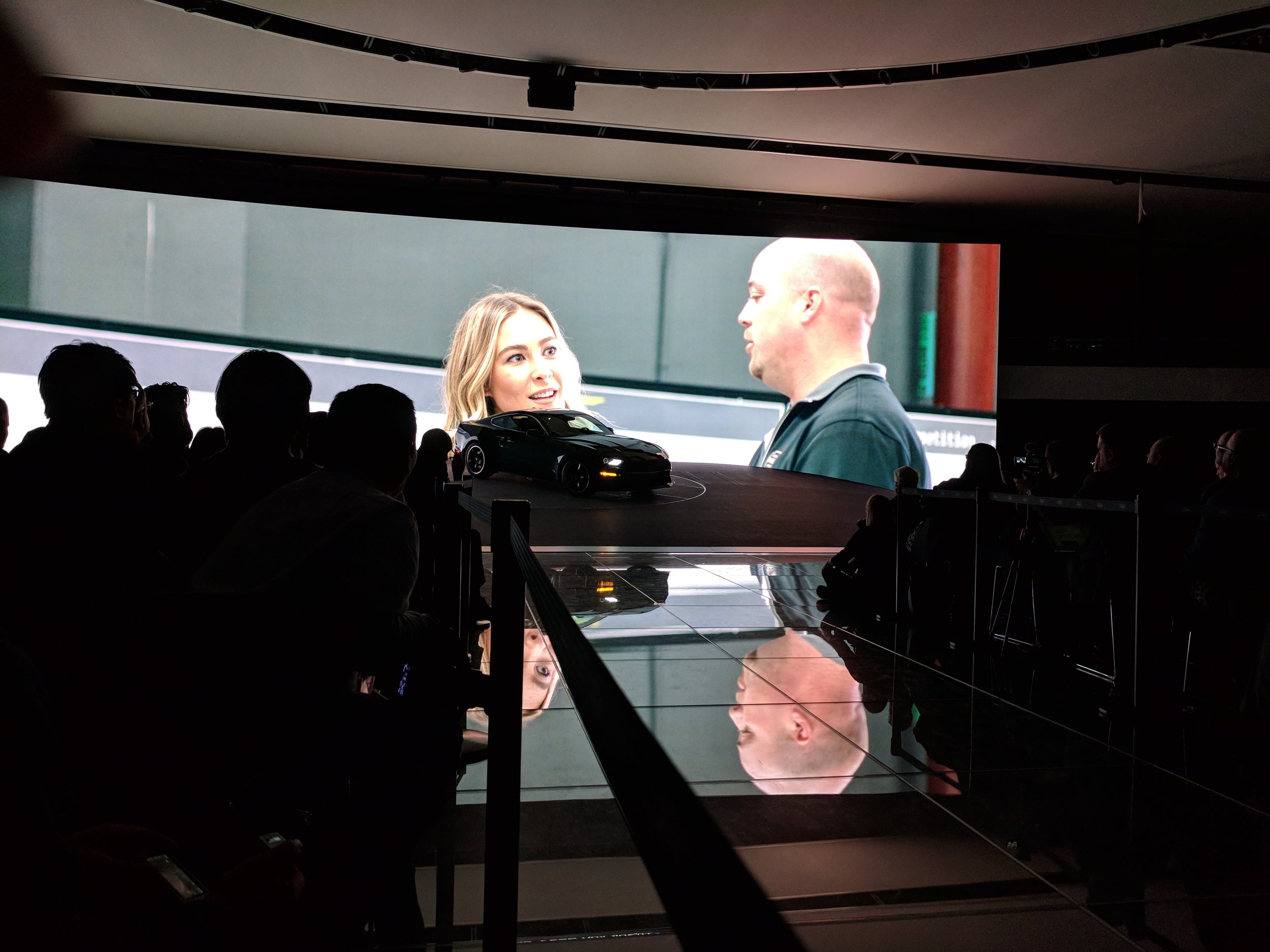
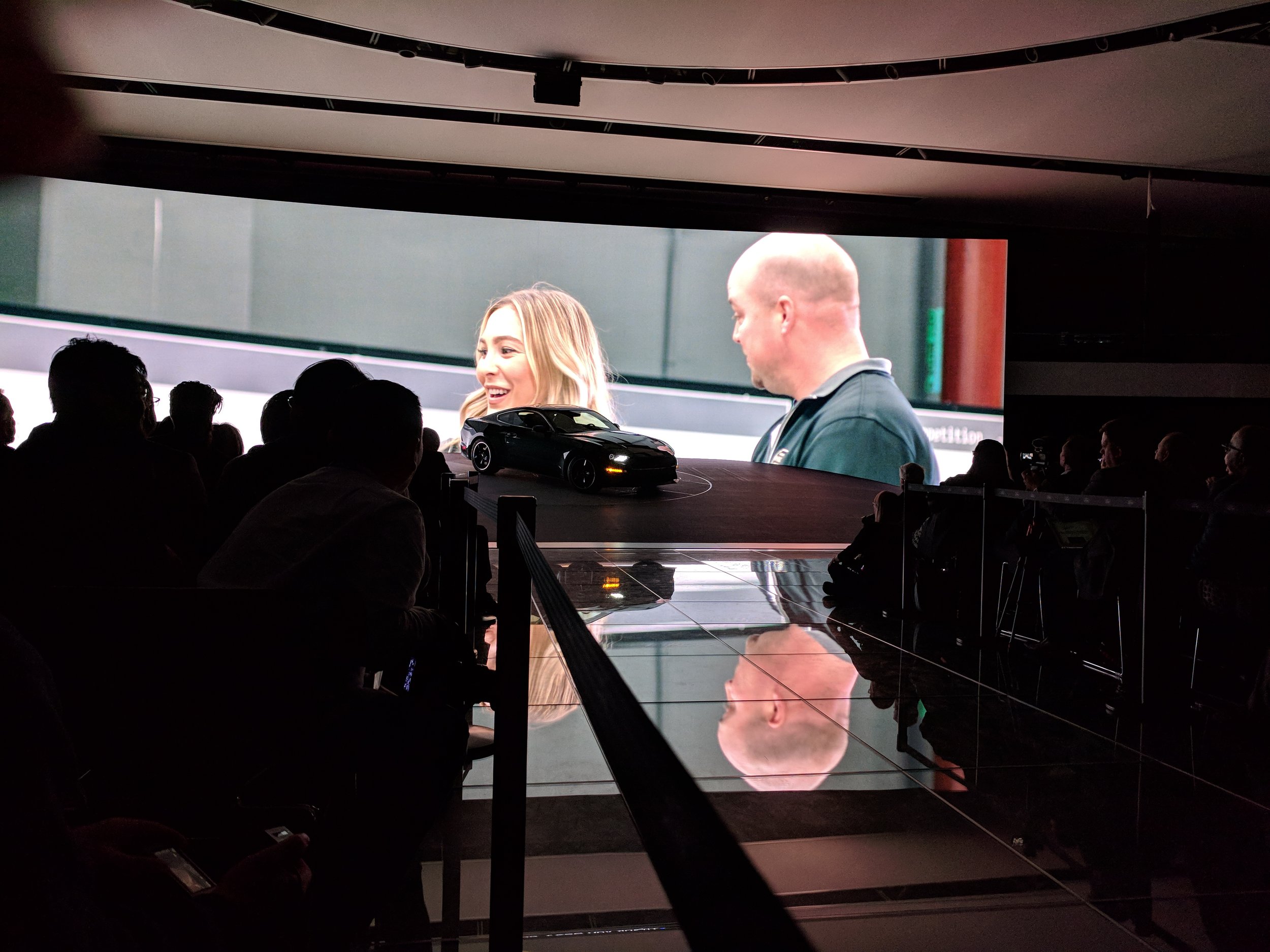
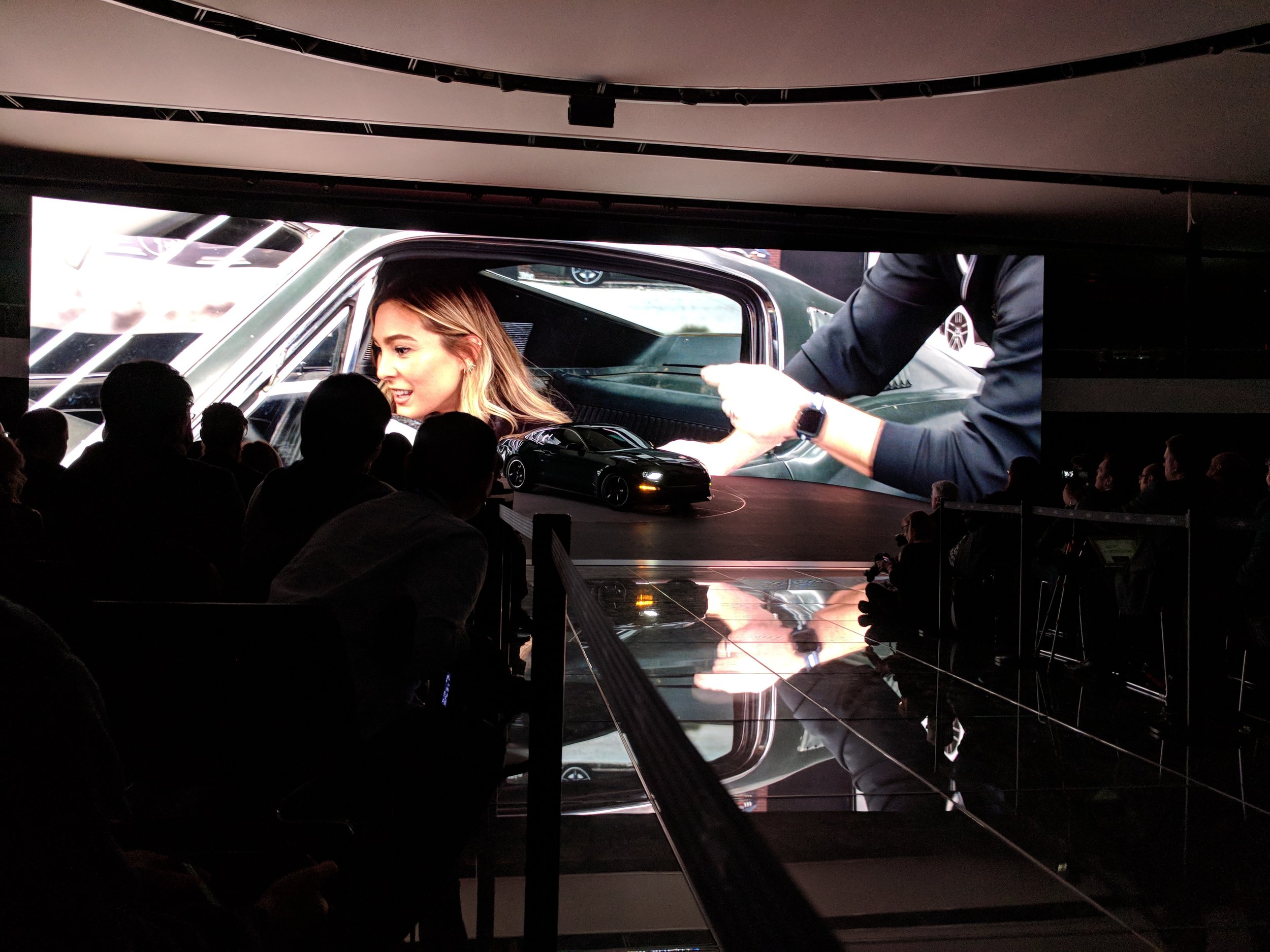
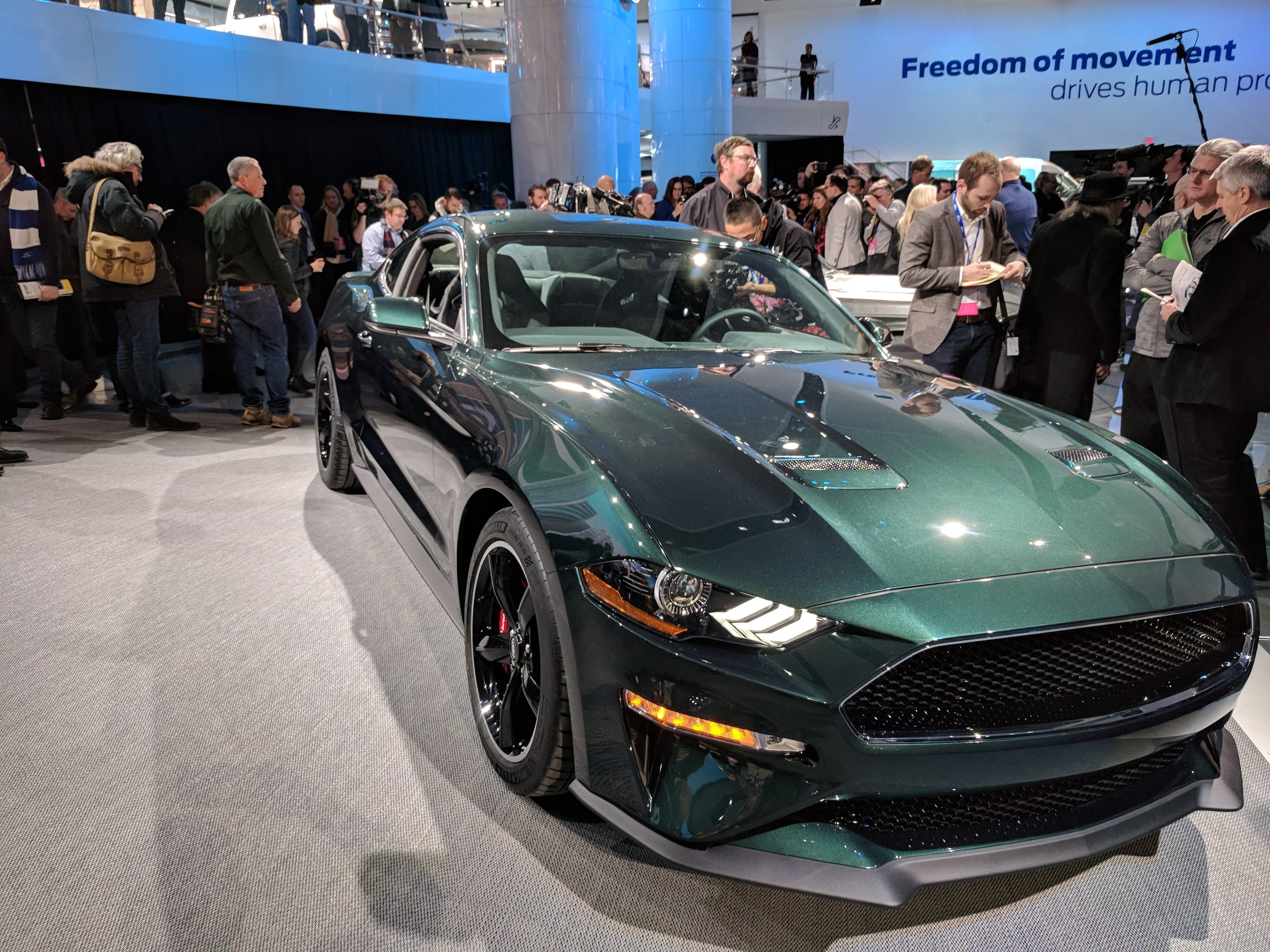
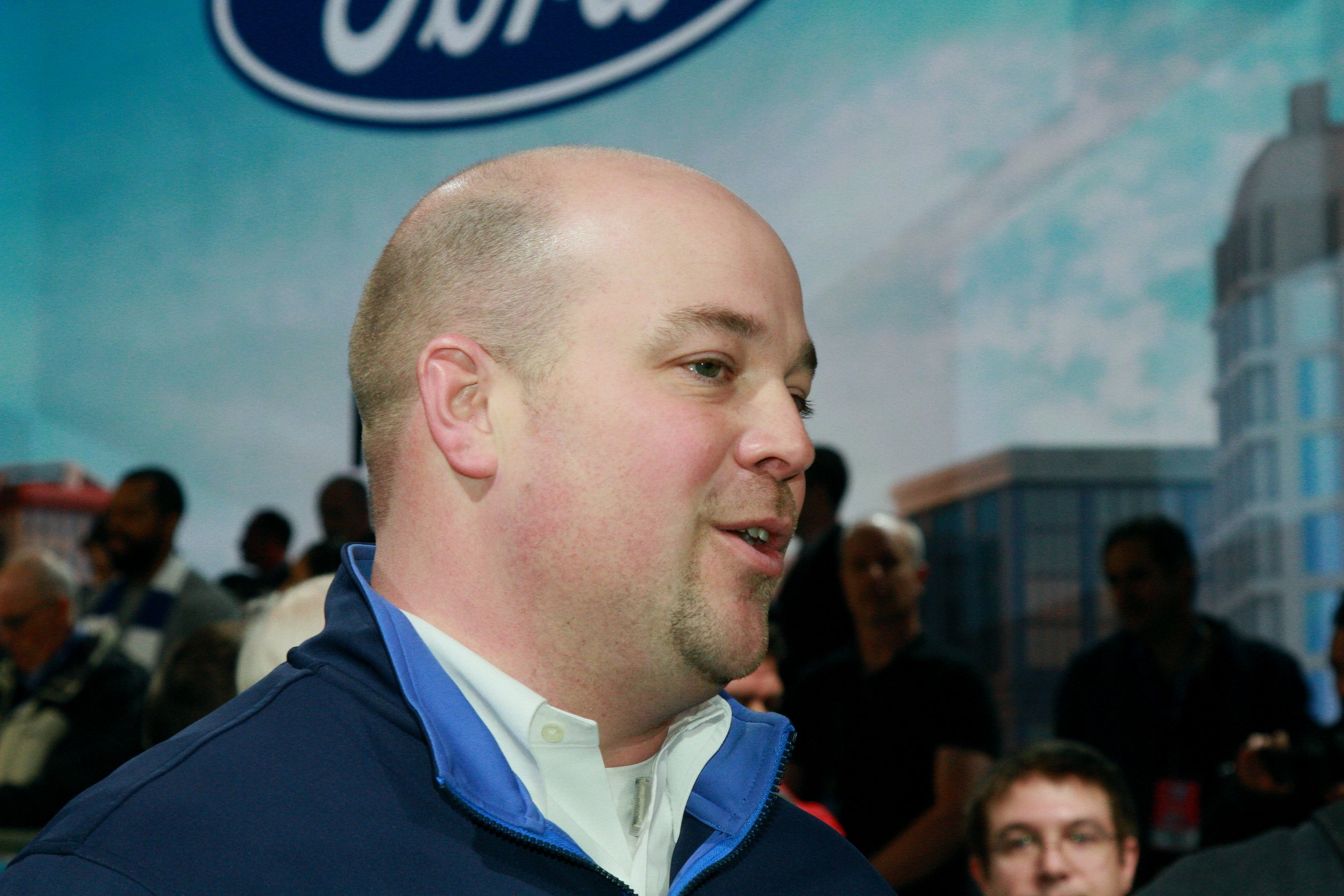
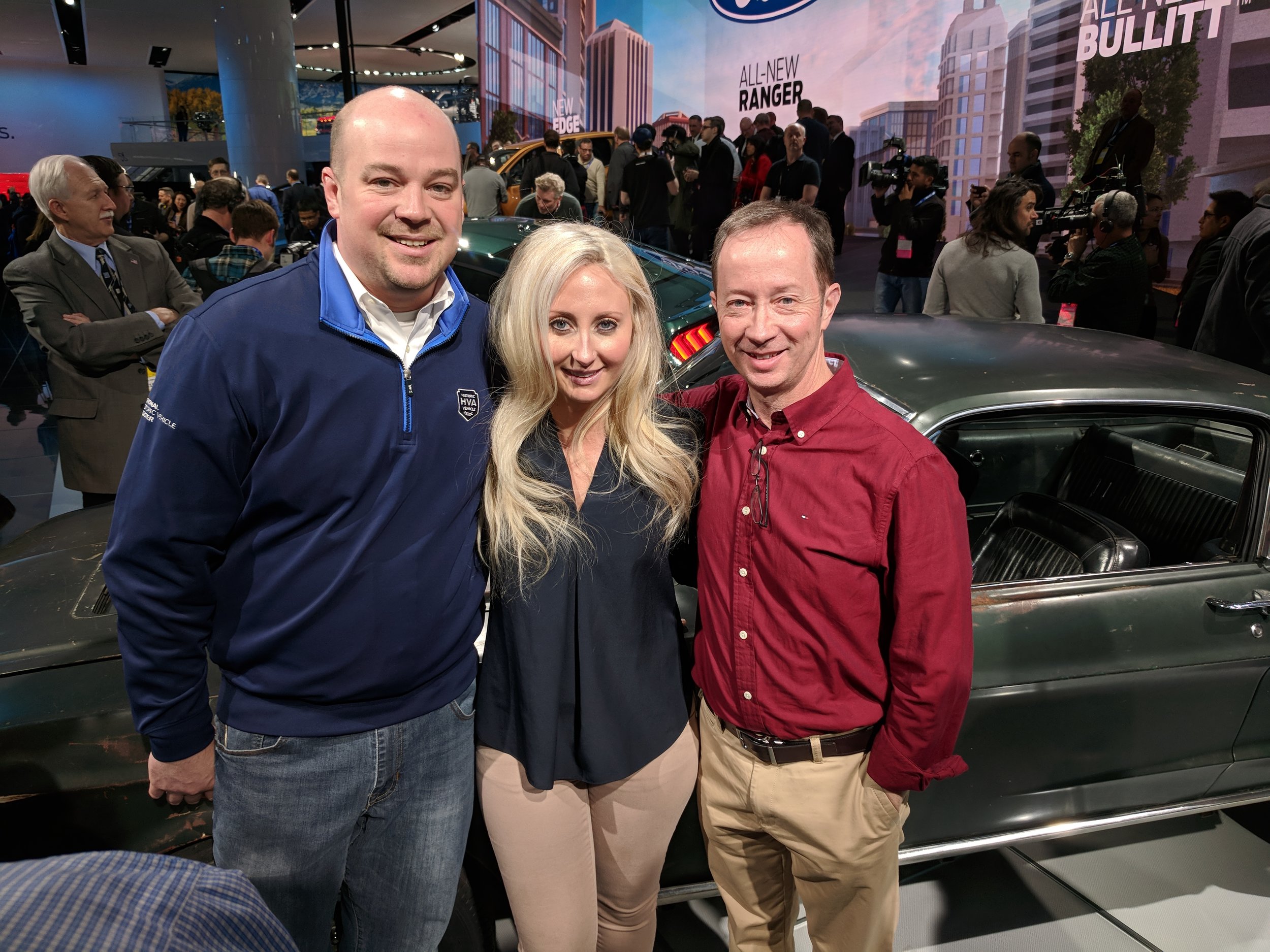
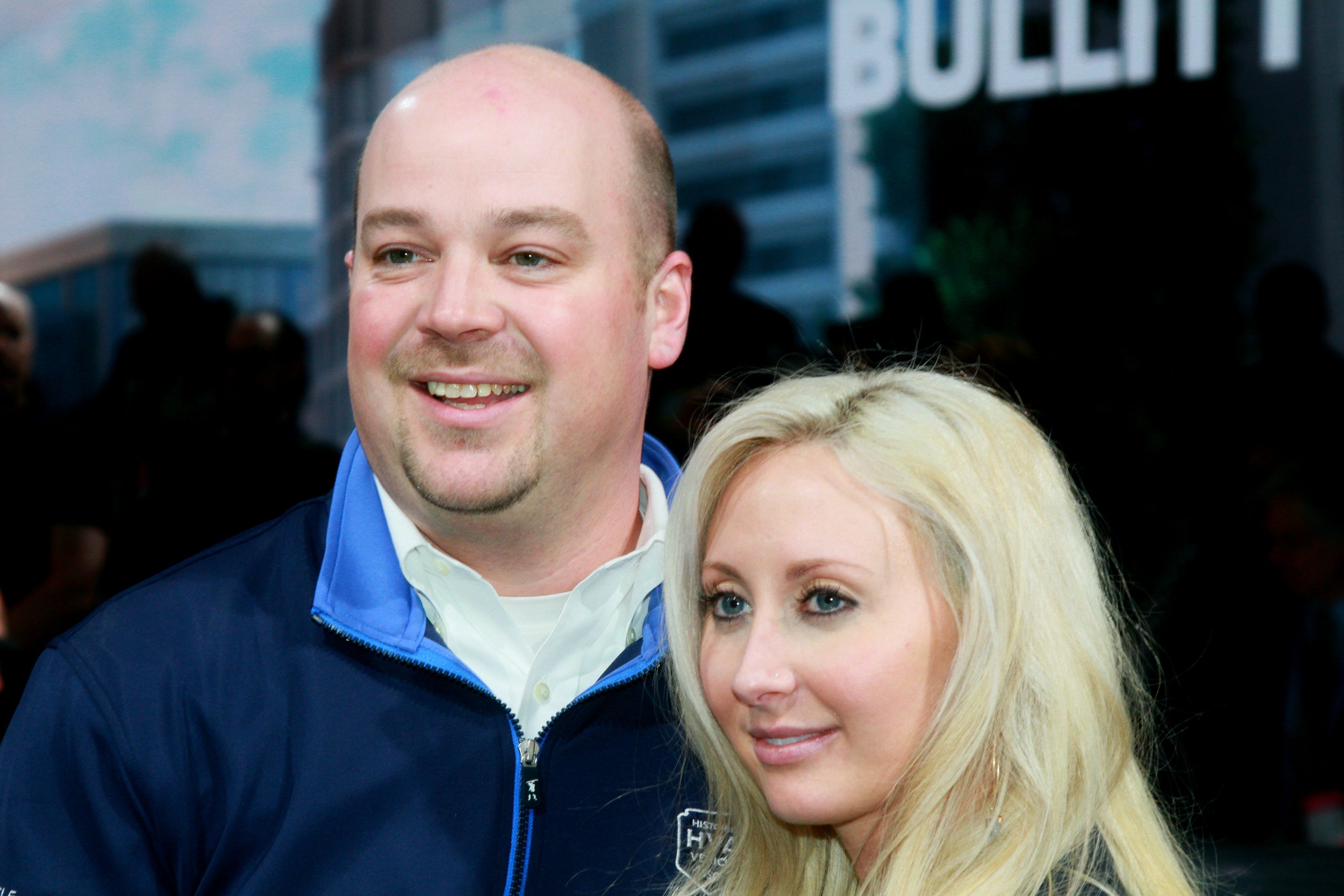
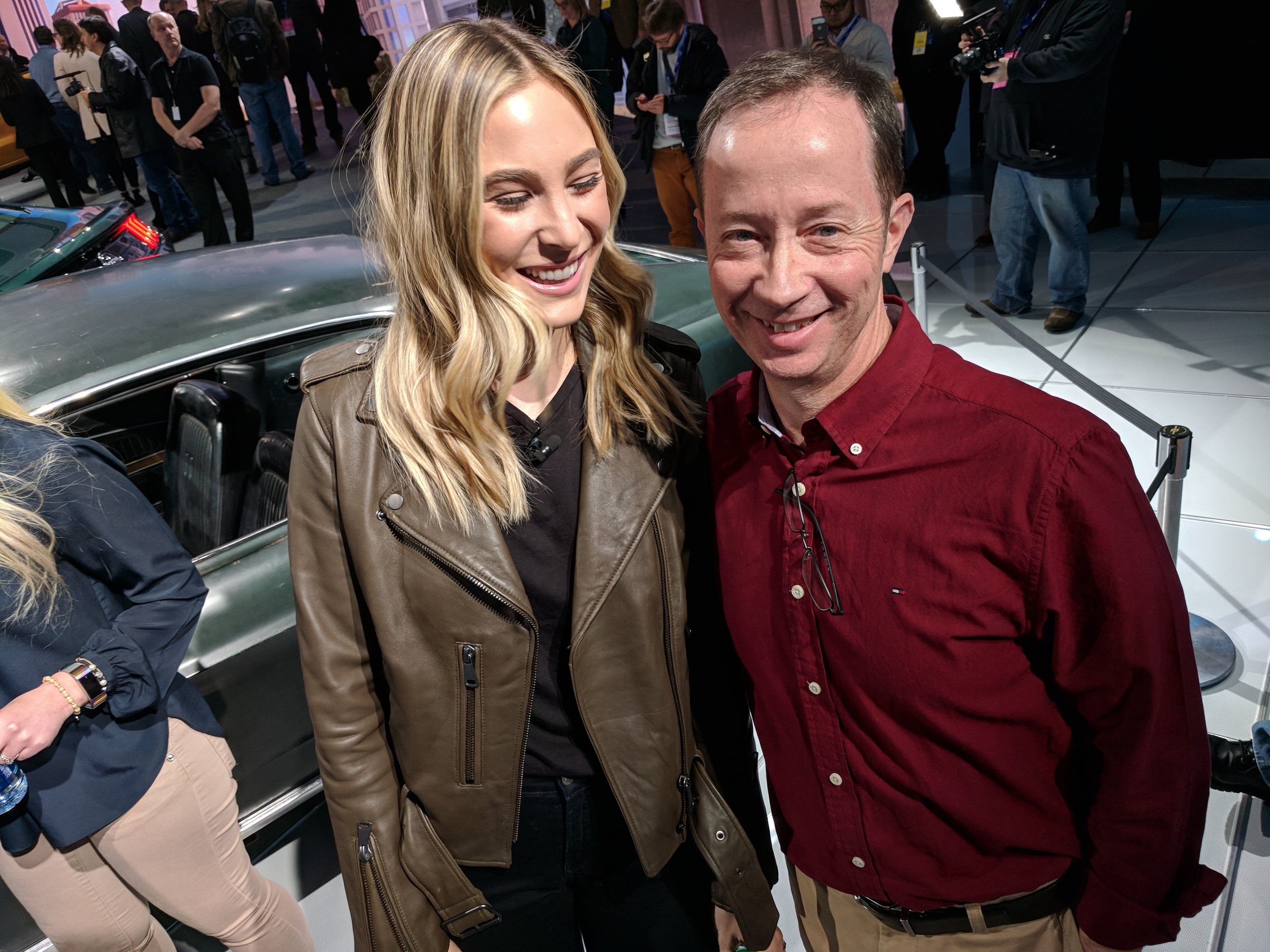
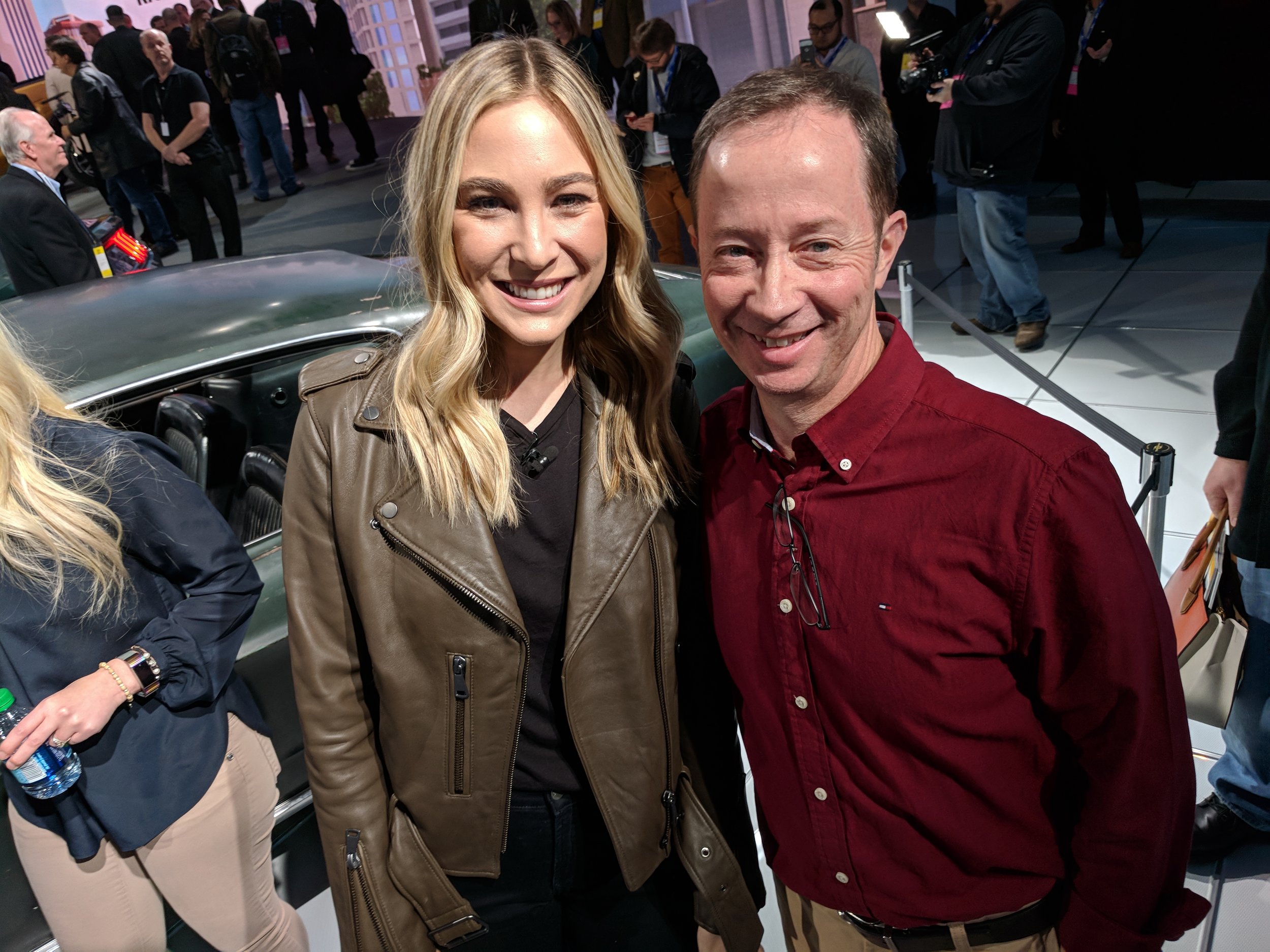
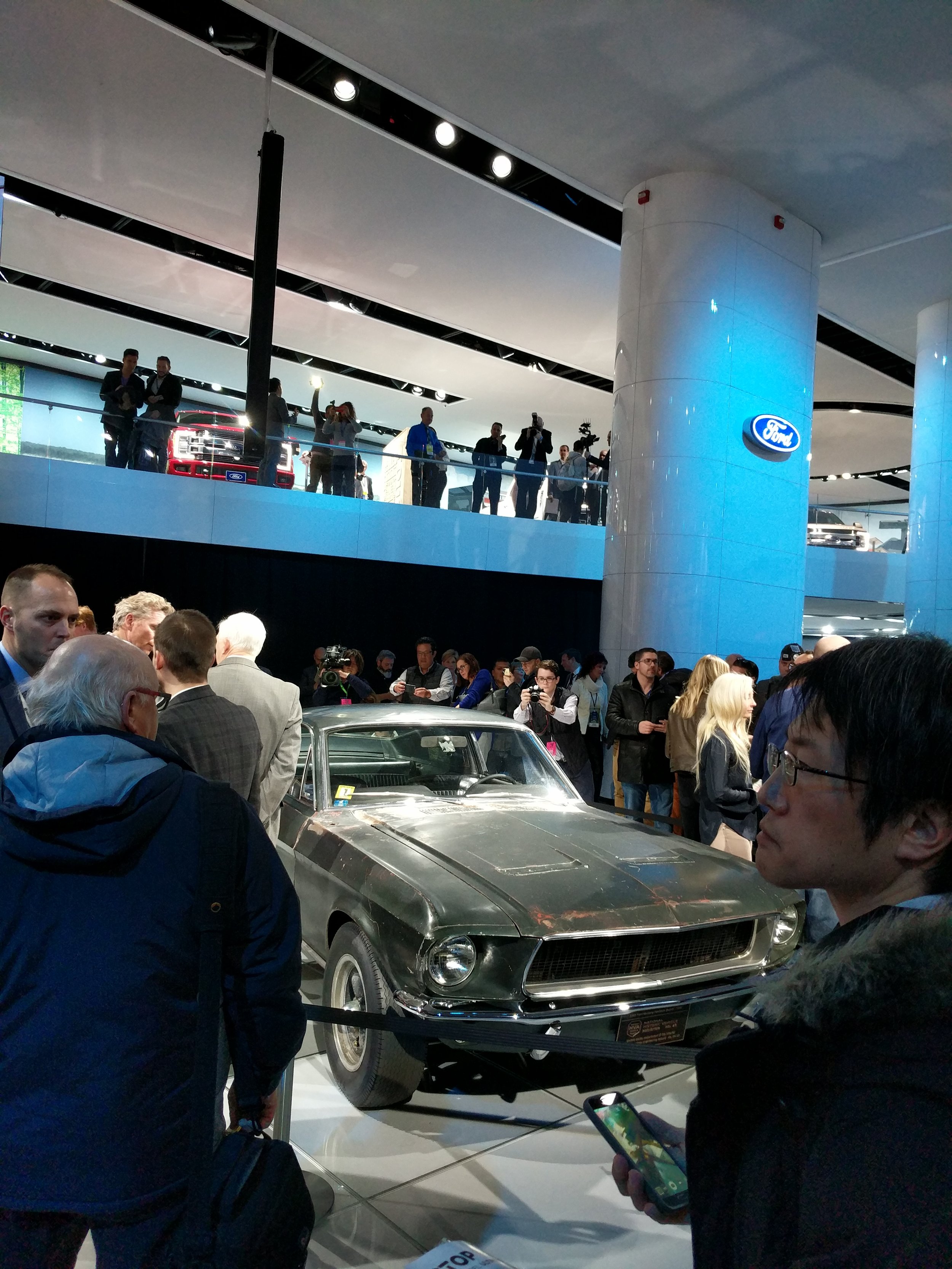
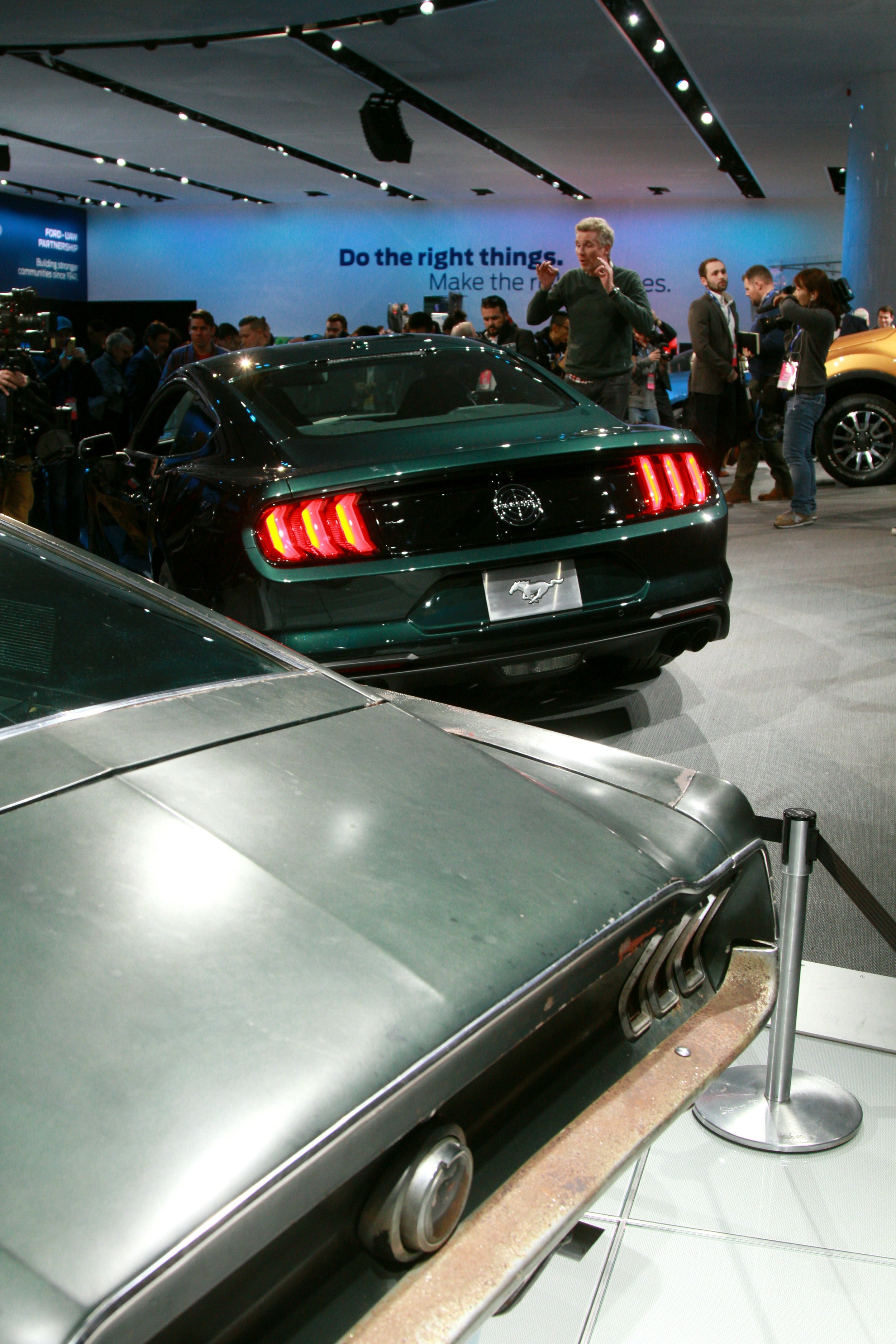
OCT. 17, 2019 -- BULLITT #559 APPEARS AT CHARLOTTE MOTOR SPEEDWAY AUTOFAIR!
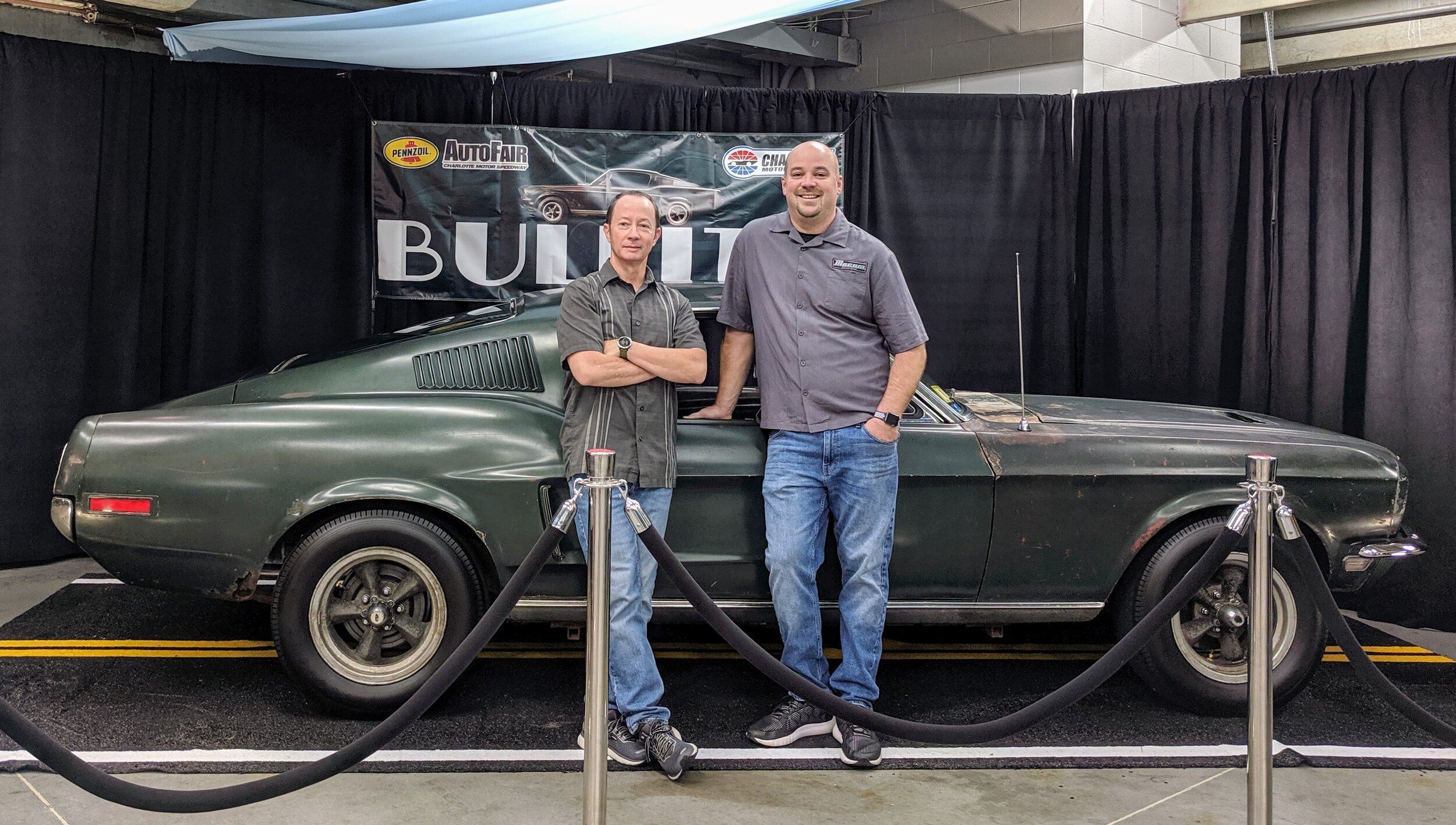

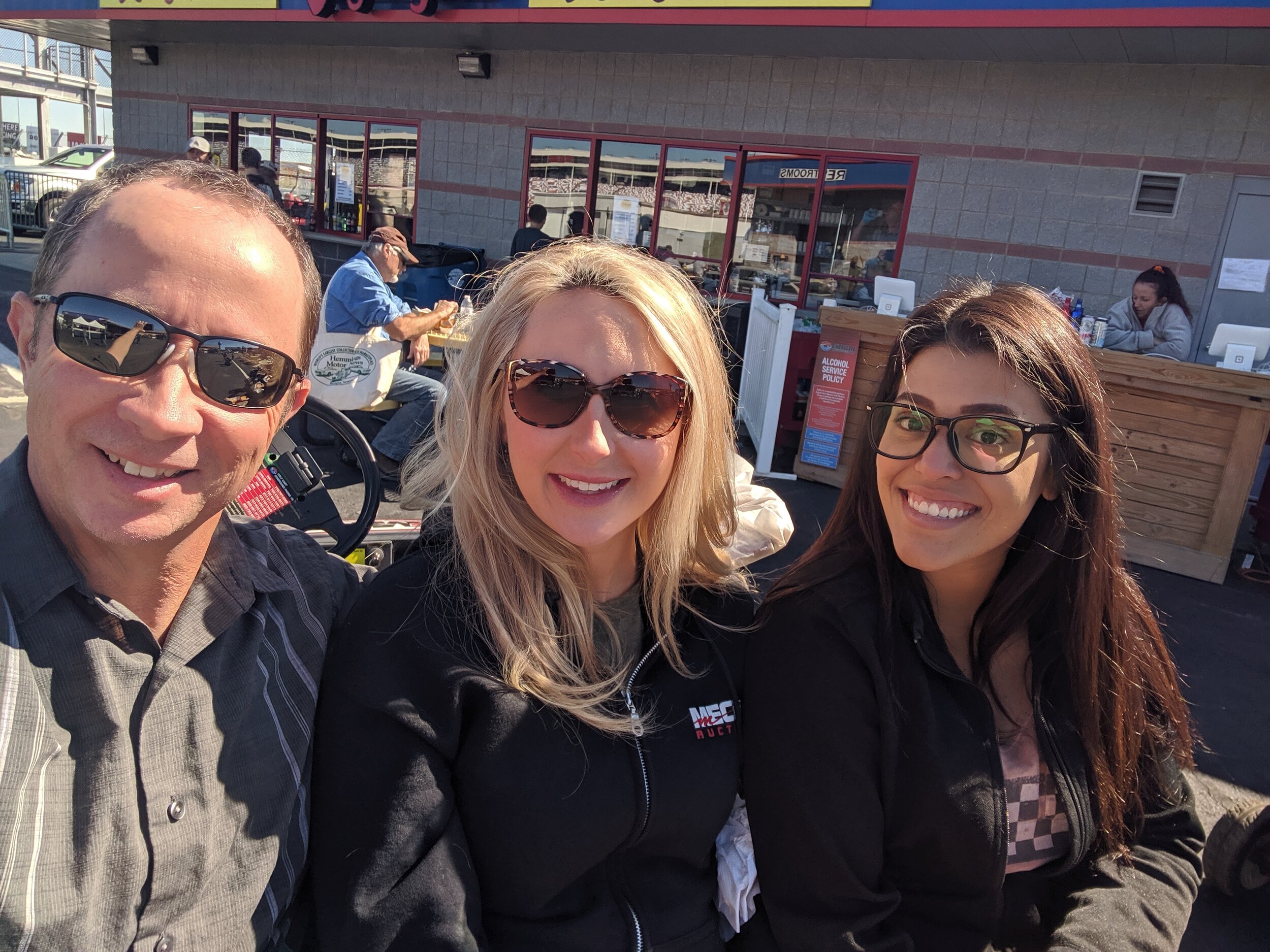
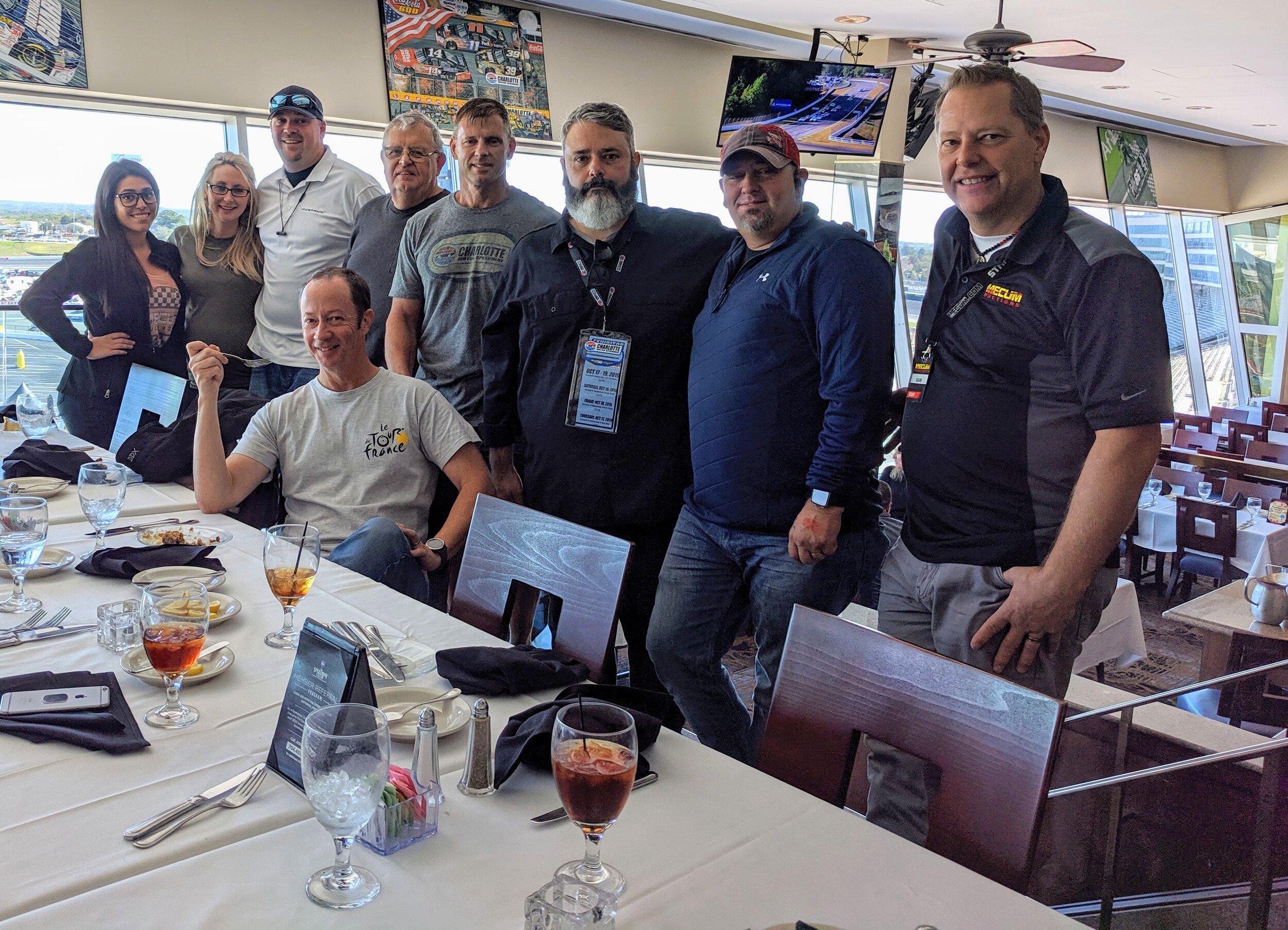
Thanks to Sean and the Kiernan family, I got to see a 25-year-old dream become reality. When I started working in the public relations department at Charlotte Motor Speedway in 1995, I fantasized about having #559 make its world debut at one of our semi-annual AutoFair car shows. I didn’t bother Bob Kiernan with my idea, because he had been adamant about keeping the car out of public view. I left the speedway in 2001 when 150 of the parent company’s employees were laid off following the 9/11 attacks, but I never lost my enthusiasm for the idea of seeing the surviving Bullitt Mustang in one of CMS’ garages during AutoFair.
On the Wednesday afternoon before the start of this year’s fall AutoFair, I walked into the special display pavilion and shook hands with Sean, who was standing in front of #559. His Mustang was headlining the show and was the focal point of a Bullitt collection comprising a pair of faithful 1968 replicas and several of the Ford tributes. The row of dark green fastbacks was more beautiful than I had ever imagined. I can’t take any credit for scheduling Sean’s car, though. While I still produce a lot of press material for AutoFair, it is the speedway’s Ed Fausel who arranges the attractions.
Heather and I spent the next three days visiting with our old speedway friends and our new Bullitt friends. (See my snapshots above.) We were also treated to a sneak peek of the upcoming Bullitt documentary by filmmaker Ken Horstmann. Ken has done an amazing job of researching the Bullitt story. If you like what you have read on my page, realize that it is only one-tenth of the information Ken has in his documentary. He has interviewed people crucial to the Bullitt story that I (to be honest) had never even heard of. I can’t wait to see it! When the release date is finalized, I will post the information here.
Sean and his wife Samantha encouraged us to attend the Mecum auction in January, when #559 is going across the auction block. As of this writing, we are very likely going to make that trip. After working on the #559 story for 30 years, I want to be present when the Kiernans turn the secret from their past into a secure future for their family.
SIDEBAR – BULLITT TRIVIA
If you consider fictional detective Frank Bullitt to be the first owner of #559, the succession of owner first names reads: Frank, Bob, Frank, Bob.
For his role as Frank Bullitt, Steve McQueen was voted World Film Favorite by the Hollywood Foreign Press Association.
Because “Bullitt” production went well over the studio’s budget, Warner ended the six-picture agreement with Solar.
Many studio-owned cars were used in the film to interact with the Mustang and Charger and it is possible to see some of them over and over if you know what to look for. The most obvious repeats are: a yellow cab, a white ’68 Firebird hardtop, a green Volkswagen Beetle, a four-door Cadillac and numerous Mustangs. Beside supplying realistic street scenery, company-owned vehicles were placed alongside the road to “catch” the Mustang or Charger in case they lost control.
Through the miracle of movie-making, the Charger loses a total of eight hubcaps during the chase scene.
Steve McQueen’s letter attempting to buy back the Mustang is dated Dec. 14, 1977, one month after McQueen and his second wife Ali MacGraw divorced.
Three years after attempting to buy back the Bullitt Mustang, Steve McQueen died of cancer. His collection of cars, motorcycles and antique toys survived intact for many years in the hands of his son Chad.
